#the aspect of differing narratives is v important to both the books and the show and by having a kernel of truth purposely neglected?
Text
after being on the hellscape that is Twitter and reading hot take after hot take now I literally want to write an miniature essay about HoTD and character resemblance to Greek mythology figures and how Helaena being a dreamer in the show is—while not from the source material and an ability that could have reasonably been given to another character—an intentional detail meant to both further flesh out the Greens AND illustrate their incompetence as a family unit + their ideologically conservative ties that mimic right-wing propaganda. In this essay I will—
#helaena targaryen#house of the dragon#I really enjoy her and I disagree w the assessment that she’s boring#however I think she’s portrayed as more neutral to the blacks for a reason and she is ignored and misunderstood by key green players bc the#greens are thematically and ideologically fraudulent by default#like them not understanding or listening to her is both neglecting their true Targaryen roots and conveniently ignoring or utilizing#the truth for power and power alone. it doesn’t make them all bad all the time but it makes them power hungry people#helaena is Cassandra#the prophet who will not be believed but knows the truth regardless#the aspect of differing narratives is v important to both the books and the show and by having a kernel of truth purposely neglected?#obvs it means something. I don’t think she would’ve stopped the war but I do think Helaena deserved better and by default everyone else#would have been better as well
13 notes
·
View notes
Text
One of the things that totally baffles and frustrates me in the asoiaf fandom is the fanon that Sansa is smarter and more diplomatic than Jon and Dany.
How can anyone read the books and come to the conclusion that Sansa is more diplomatic than Jon and Dany? On what basis is this comparison made? Jon and Dany are military leaders and rulers respectively who have successfully negotiated from disadvantaged positions. What is the equivalent of this for Sansa?
These are the issues that Dany faced in Meereen - olive trees burned down, winter on the horizon making agriculture disadvantageous, former merchants and slaves with no money and a blockade on Meereen by surrounding regions. Jon has 19 decrepit castles on the wall that he has to refit and rebuild and get ready and he has no money, food or men to do this. What is Sansa’s more smarter and diplomatic tactics to deal with these issues?
What is his tax policy? How does he feel about crop rotation? How does he handle land disputes between two nobles, both of whom think that they should have the village, so they burn it down to establish their claim. This is the hard part of ruling be it in the middle ages or now. It’s not enough to be a good man to be an effective ruler. It’s complicated and it’s hard and I wanted to show that with repeated examples in my books with my kings and hand of the kings - the prime minister if you would - trying to rule. And whether it be Ned Stark or Tyrion Lannister or Tywin Lannister or Daenerys Targaryen or Cersei Lannister trying to deal with the real challenges that affect anyone trying to rule the 7K or even a city like Meereen and it’s hard. You know, we can all read the books or read history and say oh, so and so was stupid and made a lot of mistakes and look at all these stupid mistakes they make. But these kind of mistakes are always much more apparent in hind sight than when you are actually faced with the decision about, oh my God, what would I do in this situation. How do I resolve this thing? Do I do the moral thing? But what about the political consequences of the moral thing? Do I do the pragmatic, cynical thing and kind of screw the people who are screwed by it? I mean, it is HARD. And I want to get to all of that - GRRM
https://www.youtube.com/watch?v=nJCb3xyWyAg
Where has Sansa dealt with the above issues to make a determination on how she would do better than Dany? Or even do better than Cersei for that matter?
Here is GRRM talking about how frustrating it is that he was not able to compare Daenerys and Cersei as rulers in ADWD:
His biggest lament in splitting A Feast for Crows from A Dance with Dragons is the parallels he was drawing between Cersei and Daenerys.
Cersei and Daenerys are intended as parallel characters --each exploring a different approach to how a woman would rule in a male dominated, medieval-inspired fantasy world.
GRRM, SSM, July 08, 2007
George regrets that Cersei and Dany will not be contrasted directly. He likes the extra breathing room to flesh out the characters. Bran didn't have any chapters and Dany's ending was different. Now he likes the way she ended. I think he actually may be doing more with Dany.
Comic-Con (San Diego, CA; July 20-23)
Where has he talked about contrasting Dany and Sansa? Or Sansa and Cersei? Where are the parallel leadership arcs for Dany and Sansa or Jon and Sansa like there is for Jon and Dany in ADwD?
Jon Snow has negotiated a loan with the Iron Bank, Dany agrees for peace with Yunkai by marriage with Hizdahr and Sansa managed to persuade an eight year old to eat his dinner. How are they even compared at the same level?!
It took an entire book and Ned Stark losing his head for Sansa to realize that the Lannisters were not the good guys. Despite the Lannisters doing increasingly evil things like ordering Sansa’s pet wolf killed. Her younger siblings like Arya cottoned onto that in their first chapters. Sansa then thought that beautiful, charming Margaery was simply the best and the Tyrells ended up using her. She thought Dontos was a good guy. In the Vale, she is pushing the Maester to do what LF wants with respect to SweetRobin. How is she smarter than Jon, Dany or the rest of her siblings? It’s this weird changing of canon in the completely opposite direction. Take the least smart character among the youngsters in the books and make them the smartest in fanon.
I know the show is responsible a lot for pushing this piece of fanon, when Benioff, Weiss and Cogman stripped book Jon and Dany of their leadership arcs and tried to hand them off to Sansa to prop up their favorite character.
But what’s baffling is the so called asoiaf book experts writing about stupid Jon and smart Sansa. About psychopathic assassin murder baby Arya and clever, measured leader Sansa, about ignorant, impulsive Dany and calm, compassionate, hope for the future Sansa. The thing is, no one knows on what basis and metrics they come to this conclusion. It just is. There are no detailed essays comparing Jon and Sansa’s leadership arcs, or Dany and Sansa’s arc of being rulers. But Sansa is still somehow more intelligent and diplomatic.
It’s also connected to this rather sexist strand of thought that only women who wield soft power are smart and level-headed. Tyrion is the only male character allowed to be smart and women who wield hard power like Dany or gnc characters like Arya and Brienne are impulsive, arrogant and ignorant.
In some ways I can see why this has happened. A lot of fandom want Sansa to be special in some way and have an important role to play. And since her narrative story arc is with Littlefinger, she is assigned to be the SMART one. But to be special, she has to be the only smart character.
Plus, Sansa has progressed the least in her arc compared to her peers. She’s a blank slate on whom her fans can project their desires and wishes for her character. The show did something similar - only D&D were too lazy to come up with something original and gave her Jeyne Poole’s story.
But still, there has to be a basis for such statements about the book characters. It’s not just enough to keep repeating that Sansa is the smartest ever - like ultimate hacks D&D did on the badly written garbage show did. They were rightly laughed at for their ‘Sansa is the cleverest person’ dialogue. But for some reason such statements are accepted for the book version.
The books are well written with gradual character development. Surely, if Sansa is smarter than Jon and Dany we should read that in the books? That this fanon has literally become canon despite not having any basis at all in the books is one of the most frustrating aspects of asoiaf fandom.
#Jon Snow#Daenerys Targaryen#ASoIaF fanon#ASoIaF canon#ASoIaF#anti GOT#GRRM#fandom nonsense#Fandom wank#ASoIaF fandom
189 notes
·
View notes
Note
What do you think about Kaneki x Eto?
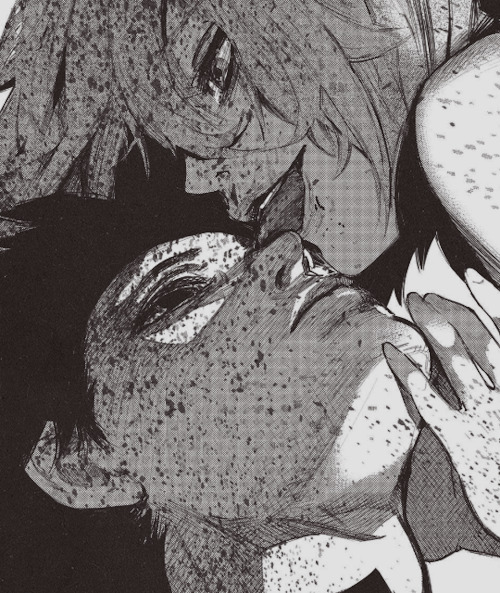
It’s my favorite Tokyo Ghoul ship? If you want to know my opinion of it, I did write a whole fanfiction on the ship. However, I can also explain my reasons for liking the ship with some character analysis. Basically, Kaneki and Eto are the same person. Kaneki loving Eto is him learning to reconcile the ugliest parts of himself. Falling in love with someone who’s just basically you in the mirror is a good way to learn some self esteem. Kaneki and Eto are the same because they’ve felt ostractized and unloved their entire lives due to having selfish and manipulative mothers, and uncaring or entirely absent fathers.
Their response to their total sense of isolation and status as outsiders is to write a story. They both have a narrative coping mechanism of the world, that’s why of all the characters they are the most highly associated with reading and books. It’s just they assign themselves different roles in the narrative. Kaneki is the protagonist of the tragedy, and Eto is the author of the tragedy. It doesn’t change the fact they see the whole world as one big tragedy. More under the cut.
1. The Protagonist of the Tragedy
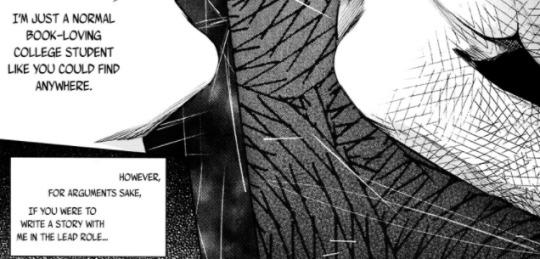

Kaneki’s coping mechanism has always been to imagine himself as the long suffering protagonist of the tragedy. His statement is twofold. “I’m not a protagonist or anything” and then “However if you were to write a story with me in the lead role it would certainly be a tragedy.”
This is paradoxical thinking. What Kaneki is saying essentially is that he is not a protagonist, but he is. The difference between a protagonist of say, a heroic epic, and the protagonist of a tragedy is that a tragic protagonist is ultimately helpless before their flaws.
Kaneki has always been outside of things. He is someone extremely isolated and lonely. He has difficulty connecting even to his lifelong best friend. Hide describes him as thus, he’s always pretending around other people and hiding his true self. Kaneki has this genuine fear of being well... genuine. He avoids emotional intimacy at any cost even though it’s the thing he craves the most.
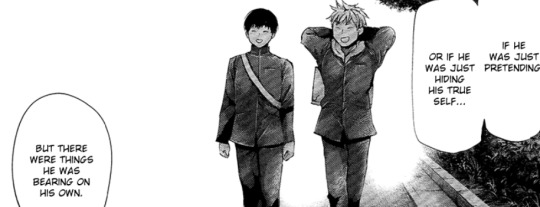
Which is why it’s easier for him to cope with things through a fictitious lens. He wants to be important to people, but he doesn’t really know how to be loved, so he always, always, always, chooses fighting for their sake instead. He plays pretend hero, pretend vigilante, and even pretend king depending on the circumstances. He is always, playing roles for the sake of others instead of trying to be his own self. He pretends to be a protagonist.
However, because of his abuse from his mother Kaneki is also unnaturally fixated on being a good person. He can’t bear to think he’s unkind, or cruel, or even violent like his mother was to him. He has such a strong, nauseous reaction to violence, he can’t even accept it within himself even when circumstances have dirven him to become violent.
So, rather than the protagonist he also wants to keep playing the victim. The victim is helpless. The victim is sympathetic. The victim isn’t to blame for their actions. Kaneki is afraid of being in control of his own actions, because he finds it hard to face himself and his own flaws and bear that responsibility. Kaneki’s coping mechanism is to feign helpelessness. To never truly make decisions because therefore he’s not responsible when he makes the wrong one.
It’s not just Kaneki who is coping poorly however. Whether or not he intends to his actions will always affect the people around him. Kaneki isn’t a protagonist, he’s merely pretending to be one. The problem with pretending to be a protagonist is that as a result you assign other people as supporting characters in your story, and forget that they have feelings outside of what you perceive their feelings to be.
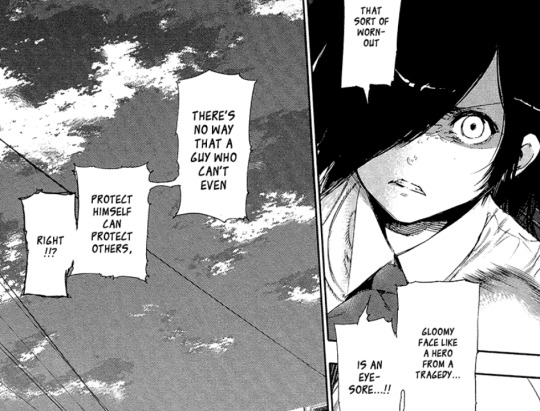
This is specificallly what Touka calls out in 120. She doesn’t want to be the heroine of his tragedy. She didn’t ask for him to protect her. Kaneki does all of these things without thinking or consulting her about her feelings at all and just assumes he knows best. Pretending you’re the protagonist gives you a self-centered view of the world. Kaneki can’t be with Touka at this point, because he can’t accept Touka’s feelings for him.

The most poweful sign of Eto and Kaneki’s connection ever is the fact that Eto has Kaneki completely read like an open book, without even really meeting him in person. It’s because they are in essence the same person. She understands Kaneki’s total sense of isolation because she’s lived it as well for her entire life.
Kaneki feels unloved and disconnected from others, and everything he does ultimately is in response to the lack of love he was shown as a child. That’s why Takatsuki’s lines, your parents failed in raising you. Echo so strongly for both of them.
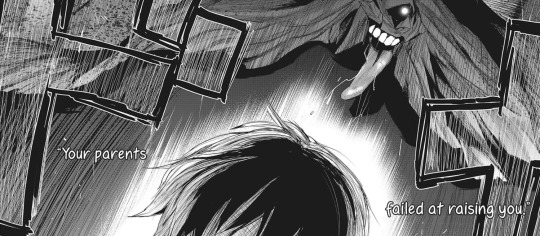
Now kiss you two.
2. The Author of the Tragedy
If Kaneki is someone who will feign helplessness, and avoid being in control of his own life then Eto is the opposite. Eto will pretend to be in control of everything because helplessness is what she fears the most. Eto was born outside of any framework or sense of stability for the world she can’t handle any of it. She longs to knock all of the structures down because they will always reject her and never include her, in the same way that Kaneki longs to be accepted by others.
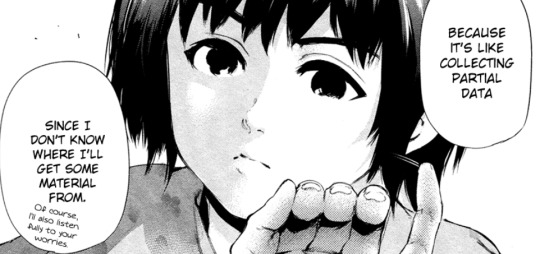
Eto reacts to the whole world like a book too, but she sees herself as the author in control of things. She’s the one writing the scenario. She chooses to bloody her own hands bcause it makes her feel in control of the violence that’s been inflicted upon her, her entire life. The things that Kaneki avoids because he’s afraid of being seen as a monster, Eto embraces willfully and becomes the monster. Eto, just like Kaneki sees everyone else as a fictional character. Whereas, Kaneki assigns them the role of support to his story, Eto sees herself as the author pitting all of the fictional characters against each other.
Kaneki lets himself be manipulated and Eto manipulates. Eto never sees herself as backed into a corner, or desperate. Everything is a planned move on her part. Everything is an intentional sacrifice. If she’s captured, it’s because she willfully walked into their plan and let herself be captured. She’s here because she wants to be. She pretends at all time that everyone is doing what she wants them to.

Even when captured and imprisoned in the cochlea, Eto intentionally walked in as a part of her big plan. The thing about Eto’s plans, and plans, and plans is that she’s bad at admitting when she’s losing or things are out of her control. Aogiri could never win an all out war against the CCG. Which is why Eto was too quick to burn Aogiri in a deliberate sacrifice to try to weaken the CCG as a part of her plan, rather than try to take her hands off and try a different approach.
The same way that Kaneki never wants to take control of his own life, Eto never wants to let go of her sense of control. Which is why she’ll pretend to be control even when she isn’t. Eto is just good enough at reading and manipulating people that she can delude herself into thinking that the situation is always in the palm of her hand when it’s not. Which is why things that are genuinely out of her control and impossible to predict have a tendency to explode in her face.

Even when Eto loses, she always sees it as a controlled lost. She wanted Kaneki to defeat her on the Tsukiyama Tower and devour her Kagune. She gave him that victory. She is still in control. She is always the author writing down the tragedy.
The key difference between both of them is that Eto externalizes, and Kaneki internalizes. Eto is trying to fix the world to make up for the inadequacy she sees inside of herself. Kaneki is trying to fix something in himself so people will find him lovable.
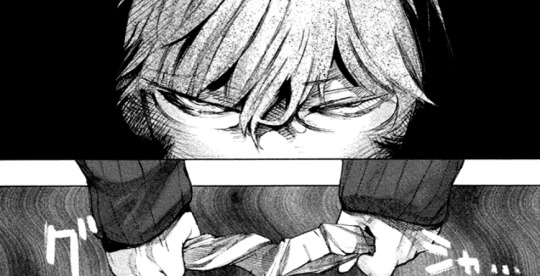

We see in Takatsuki’s flashback chapter that Eto’s resentment of Kuzen and his cowardice, has just as much to do with her desire to destroy V and as her wish for a better world. Kaneki and Eto’s trauma informs their actions just as much as their genuine desire to improve the world. They are wholly created by the traumatic circumstances that have affected them and been poorly coping all of their lives.
The best example to show them poorly coping with trauma is to show how they lash out. Kaneki and Eto are both children raised without any love, and they’ve come to two different conclusions. Kaneki sees himself as unlovable. That nobody is capable of loving him so he sees all relationships as a transaction and services rendered. Eto is the opposite, rather than an internal quality she focuses on an external one. She believes actual love doesn’t exist. That all love is selfish, just like her parents’ love for her ultimately was.
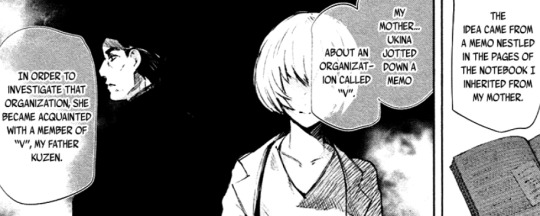

It’s shockingly different the way Eto and Kuzen tell the stories of her birth. Kuzen focuses on the love story aspect, as if Eto was genuinely the product of a love that bridged the gap between two different worlds. Eto believes that her mother was only using Kuzen and sleeping with him to get information, and that she was just an unplanned pregnancy. Eto is incapable of understanding her mother’s love for both her, and her father and chooses to believe no love exists at all. Kaneki on the other hand is incapable of understanding his mother’s contradictory love for him, and chooses to believe himself unlovable.


The person I loved so greatly beat me. I loved my mother, didn’t I?
Kaneki and Eto are hurt not because they don’t love their mothers, but they do. Their mothers are extremely important to both of them. Yet, neither mother seems to love them back. Ukina chose Kuzen over protecting her child. Kaneki’s mother chose her sister, and everyone else in the neighborhood to take care of while neglecting and outright beating her child when he asked for basic care. Eto does everything she does in Ukina’s memory to complete her mission, and Kaneki does everything to try to be the good boy his mother wanted him to be for a good portion of his life but neither of them feel loved by that mother figure. Kaneki and Eto were failed on the most basic level by the parents who were meant to be responsible for them and loved them and as a result they are continually coping with that lack of love.

The difference in their coping can be seen how they both treat Kanae. Kanae has an incredible amount in common for both of them. She lives seeking love, she has been orphaned and unloved and treated like an outsider in the Tsukiyama household her entire life even though they were supposed to take care of her as her direct family. She always had a close relationship with her mother before she died. She lives by pretending to be something she’s not in order to look stronger.
Eto’s response is to insist that Kanae’s love is selfish. That she’s an ugly, monster for trying to force her feelings upon Tsukiyama. Eto goes out of her way to try to prove that love is a lie.

However, Kaneki much more passively also resents the hell out of Kanae. Kaneki’s wish to be loved is the same as Kanae. Kaneki will even become violent for the sake of that wish.

However, this is his response to Kanae at her lowest point.


Kaneki’s choice to internalize all of his trauma inside of himself is one that also results in destruction. Remember that this is after Tsukiyama begged Kaneki for mercy on Kanae.
Kaneki’s habits of pretending to be helpless to avoid conflict, lead him into as much conflict as Eto gets into. The coping mechanism is different. The end result is the same. As Haise he spent the entire arc putting off conflict, but he ends up fighting Tsukiyama anyway, ends up brutalizing Kanae in the worst way possible, and even ignores Yoshimura’s wish to save Eto.
They cope very differently. Kaneki is always trying to change himself to suit the needs of other people. Eto is always trying to change other people to suit her own needs. However, the end result is the same. Kaneki’s seems more selfless. He’s letting himself suffer rather than make others suffer. He’s trying to hold it all in, rather than Eto who pushes all of it out. But, both are unhealthy. Eto wants to destroy the world, Kaneki wants to destroy himself.
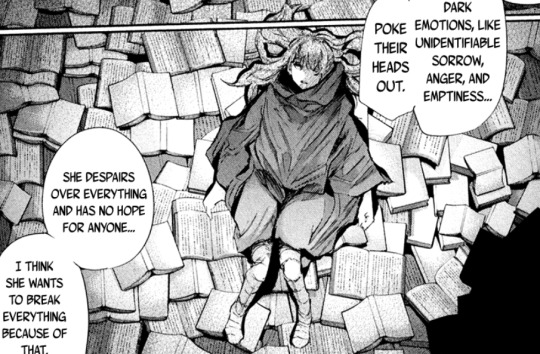

The result is still destruction regardless. Which is why the way Kaneki and Eto both treat Kanae is so important, they’ve both projected themselves onto Kanae, and want to destroy her because of it. They’re coping mechanisms which are meant to preserve them are instead self destructive. Which means ultimately they’re both terribly unhealthy people. The question of which one is good or bad doesn’t really have anything to do with it.
Kaneki and Eto’s relationship is so interesting because they’ve both been pushed to the point, where they’ve stopped hoping for things, and just want to destroy everything. It’s just what they choose to destroy is different, Kaneki wants to self destruct, and Eto wants to take the whole world down with her. That’s why I think they should work together to smash everything into tiny little pieces, and maybe kiss a little bit. There’s just something to be said about a relationship that’s built around learning to love the unhealthiest parts of yourself.
143 notes
·
View notes
Note
Hi, I wanted to ask if you have read Code Name Verity? I don't have a specific question but I'm probably going to be very inspired by that book when I'm writing. And I wanted to see if I either shouldn't do that, or if there were things I should be careful of in regards to its portrayal of torture. Thank you
I’m afraid I haven’t read it Anon but I do have some resources that could probably help you compare the story to reality and make a judgement for yourself.
You might have already read these posts, but I think it’s probably worth putting them all together and talking a little about how the information in them relates to each other.
Going by the wikipedia summary Code Name Verity is a piece of historical fiction centring on two friends who go into Occupied France together. One, ‘Verity’, is captured by the Nazis and writes a confession that forms the first part of the book. Her friend tries to rescue her but ends up killing her in order to prevent Verity from being tortured for information or being used in unethical medical testing. She destroys the prison where her friend was held and after the war is acquitted of Verity’s murder.
Based on that summary these are the masterposts that I think are relevant:
The post on forced confessions
Why torture can’t work as an interrogation tactic
What torture actually does in an interrogation
How torture effects investigations
The common effects torture has on survivors, torturers and witnesses
The effect torture has on memory
The two posts on medical testing which can be found here and here.
The general introduction which covers a lot of common misconceptions about torture.
And the post on National Styles during the Second World War period.
Torture can lead to confessions but these confession do not necessarily have any basis in reality.
And by ‘no basis in reality’ I don’t just mean that people will sometimes confess to things they didn’t do. I mean that we have records of people confessing to things that are biologically impossible under torture. (I have no idea why historical European torturers were so taken with the idea of cis gender men giving birth but hey ho-)
We do have an estimate of the ‘success’ rate for forcing confessions from historical sources. It’s about 10%. Which means that while it’s possible if torture is the only factor at play the vast majority of people will not confess.
And this makes me question framing this sort of story as something that’s extracted by force rather then volunteered. Don’t get me wrong, the idea of a secret narrative told while imprisoned has power- I just keep comparing it to Valorie’s letter in V for Vendetta and I think presenting it as a choice or a tiny act of resistance is both more in keeping with reality and more humanising for survivors.
I think it’s important to remember that torture makes people less able to tell the truth. It makes memory loss and inaccurate memories more likely and the long term psychological problems it causes can colour how people think about and relate to the past.
None of this makes the idea of having a prisoner relay their story like this a bad idea. I just think that you should try to find a reason for the character to do it. And torture isn’t really a motivation.
Trying to talk someone around is. Or stall for time. Or convince the other side they’re outmatched.
And this stories doesn’t necessarily have to be relayed in a way that’s accessible to the guards. It could be a hidden message like Valorie’s or one that’s told in pieces to other prisoners, religious figures, cleaners etc.
The plot line in the book that has Verity murdered in order to save her and then has her murderer acquitted sits a little uncomfortably with me. I can’t say that it is apologia, I think that a lot depends on context and since I haven’t read the story I don’t have that context.
It isn’t unrealistic. People have definitely acted like this, across time periods and cultures. Suicide, assisted suicide and murder in response to threats of torture and other violence have happened and they have been justified by the cultures they happened in.
There is nothing wrong with depicting that and capturing it as part of the world you’re building in your story.
But it does skirt a little close to that idea that torture survivors’ lives end when they’re tortured. That they may as well be dead because there’s nothing good ahead of them.
And that’s just not true.
Life for survivors is hard. Dealing with disability and complex mental health problems is hard and many of them have to deal with rejection by the community on top of that. But none of this means life isn’t worth living or that there are no good things in it.
Disabled people and people with mental health problems have managed to survive and thrive throughout history. Torture survivors are no different. They build careers, find love, raise families, make art, just like the rest of us.
That doesn’t negate the fact that some people will choose to die rather then be tortured. Or the fact that suicidal thoughts and feelings are a common symptom in torture survivors.
One way to get around this kind of bind is to have more the one survivor as a major character in the story, which lets you show differences in symptoms and outcomes.
I’m not saying that having a torture survivor die is always a bad narrative choice. Showing a survivor character having a terrible life after torture isn’t necessarily a bad narrative choice either. Both of these things might be the right choice for the character and the plot in your story.
But they shouldn’t be the only inevitable outcome for all survivors.
This might sound like a lot of negatives but I think that ultimately any changes you make are probably going to be minor. A lot of this is about how you frame the elements of the story, not the elements themselves. Thinking about how those elements are framed and what the character’s deeper motivations are will also help you capture the character’s experience. It should mean that the character comes across clearly in every aspect of the story, even when they’re at their most powerless.
I hope that helps. :)
Available on Wordpress.
Disclaimer
#writing advice#tw torture#tw Nazis#tw genocide#historical fiction#historical torture#World War 2#forced confessions#torture survivors are not broken#writing survivors#writing victims#effects of torture
58 notes
·
View notes
Text
let’s talk about the themes of the Sly games
Sly Cooper and the Thievius Raccoonus (2002):
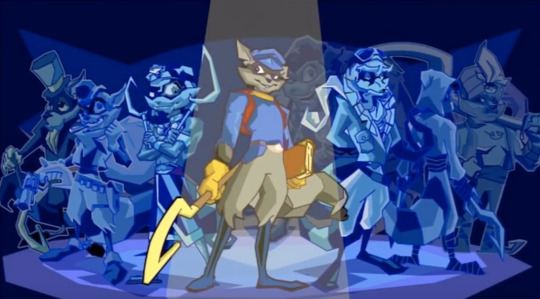
Paris: this might not be the game’s main theme but it’s the theme that is most omnipresent. Paris is the glue that connects everything together. it immediately has such an impact on the player, even though it’s just the tutorial and the gang’s base of operations. Sly being a thief but also living in Paris just sounds so right, like it’s the way it should be. it fits.
The Thievius Raccoonus: this is the main theme and what provides the game with its premise. it’s the book that needs to be glued back together and its importance is highlighted throughout. almost every level has a page included so we’re constantly reminded of its significance. the skills we earn by retrieving the main ancestors’ pages elevate the gameplay and force the player to respect it. other than that it’s a clever way to spotlight the ancestors and establish that Sly does come from a long line of thieves.
Family: this doesn’t need much explaining but i’ll do it anyway. we start off with Sly’s parents getting killed and him landing at an orphanage where he creates a new family for himself with Bentley and Murray. you’ve got 3 different types of family: (A) Connor and Sly’s mom getting murdered and Sly’s aim to avenge them, (B) Bentley and Murray being true brothers when Sly was left with no one (i’m tearing up), and (C) the ancestors, which are explored more in-depth through the theme of The Thievius Raccoonus. Family as a theme explores Sly’s motivations and drive, even though Connor’s role is minor, especially in comparison to his role in Sly 3
Morality: Sly 1 is rudimental in its gameplay. it was a little game with a big promise at the time it was released, hoping to serve Sony and the Playstation 2 with a worthy mascot and an even worthier title. but right off the bat the player is bombarded with a shit-ton of lore about the world Sly lives in and how he operates. we immediately find out he’s an antihero, an honourable thief who has a code of conduct. this comes into stark contrast with the game’s villains who are basically filthy crooks. thief takes down thieves and the theme of Morality is SP’s attempt to make the player distinguish between good criminal and bad criminal. Morality as a theme is spotlighted immensely in Cold Heart of Hate when Sly saves Carmelita because he truly is the good guy, but also when it’s revealed that what’s been keeping Clockwerk alive all these years is the lack of morals and the hatred. the game establishes Morality as the outlining theme of the entire series, placing Sly on a pedestal because he’s honourable. morals trump hatred, so fuck off Clockwerk (even though ‘perfection has no age’ might be one of the coolest lines in the game lol)
Sly 2: Band of Thieves (2004):

Paris: this is the theme from the first game but on steroids. like make it x10. when you take the plot of Sly 2 and boil down to its core, it turns out to be a full-on race against time to save Paris. it provides both a nod to the first game and a sense of closure at the end: the game begins in Paris and ends in Paris. It’s both a setting and a catalyst, and it is absolutely brilliant in the game. you spend most of the game globetrotting, away from home but as soon as you find out ClockLa is on her way to unleash her psychotic brain waves and turn the city evil, you find yourself at the edge of your seat, caring more about Paris than anything else. it’s omnipresent and powerful and i don’t know why but i love it.
Spice: if you wanna be my lover. here’s an amazing replacement for drug trafficking as a plot device in a children’s game: spice. the spice trail is what pushes the narrative forward but also gives the gang something to face before the pieces fall into place and the larger scale of things is revealed. before ClockLa steals the show, spice is the main antagonist in the game. it brings the villains together, leads the gang from one location to another, provides some memorable missions and obstacles (Spice in the Sky and a raged, spice-infused Murray). but it’s not to say that it fades away in the long-run. Spice is actually the subtle thread that connects the episodes together but also is significant to the final master plan of hypnotising Paris.
Deception: obvious one here. Neyla pretending to be an ally is the major example. we’ve got the Contessa pretending to be loyal to Interpol, we’ve got Arpeggio seemingly being the mastermind behind everything (which he kinda was until he wasn’t), we’ve got the whole evil plot reveal on the spice, we’ve got Neyla ripping off Arpeggio on her journey to become the most well-written villain in video-game history. lots going on here. overall great theme. on a wider scale (and i’ve touched on this before in some recent posts) we’ve got SP deceiving the player into thinking the plot is all laid out at Rajan’s ball until it all turns to shit and nothing goes as expected. Appearance V Reality is a sub-theme that pops up when Bentley fights Jean Bison and Bison constantly underestimates Bentley until the turtle fucking blows his lights out. it’s not an instance of Deception per se, but it’s worth mentioning
The Past: Clockwerk’s return makes this a theme instead of a motif. before ‘saving Paris’ becomes the main objective, it’s Sly’s determination to prevent Clockwerk’s revamping that kicks off the game’s events. the events of Sly 1 play a pivotal role here as they lay the groundwork for the plot of Sly 2. it’s not just Sly 2: The Sequel. with its own set of characters and an intricate story it becomes its very own thing. but Clockwerk is the link that connects everything.
Morality: this one sneaks up on you in the game’s second half and just bites you right in the ass when you least expect it. Contessa, who until her boss-fight seems to be just another selfish spider bitch witch, manifests into this advocate for Sly’s inner demons through simple dialogue. fucking brilliant. ‘You’re an ignorant child playing dress-up in his father’s legacy’ (in my opinion, the best line in the entire series) kicks it all off. and then the theme becomes obviously present throughout. it explores the fine line that Sly walks between robin hood and scumbag thief, it shows how the villains are down-right criminals who want to benefit from their crimes, it cracks black and white into a million pieces because in a single game there are like a million layers of good and evil: Barkley at the very top as the authoritarian white, Carmelita as a sympathetic cop who tries to grasp onto her own code of ethics while occasionally running with the thieves, Sly and the gang as antiheroes, the villains as... villains, and Neyla as the embodiment of satan. it’s a scale and the game spotlights this. i had a different bullet point for Justice but i think it falls under Morality. basically, Carmelita’s story arc in Sly 2 deals with blurring her views a bit and re-defining justice
Sly 3: Honour Among Thieves (2005):

Ancestry (Cooper Vault): this is what the game is all about, or at least the premise. after stitching the cottdamn book back together by the end of the first game, Sly 2 doesn’t give any attention to the Thievius Raccoonus. in fact, Sly 2 exists on a completely different plane, using its amazing plot to elevate itself away from the lore of the first game. ancestry is rarely mentioned. flashforward to Sly 3, where SP takes us back to the mythos for a new caper involving a new reveal: the Cooper Vault. what we thought we knew about the ancestors is thrown out the window to pave the way for this mystical place where the Coopers buried their secrets and their loot. i’d like to point out that the theme of Ancestry is great and all but SP does a shitty job in spreading it throughout the game. whilst recruiting the new gang members we often forget why we’re doing so and it’s not until the last episode of the game that we get the fulfilment of the theme’s promise. it’s also worth mentioning that the theme pops up in A Cold Alliance when Tsao is comparing himself to Sly and he speaks of his ancestors but we somehow get the feeling that his ancestors were all colossal jerks like him and had absolutely 0 honour
Family: this is not the same as Ancestry. the new gang members could have very well been distant with each other if not for the adventures that made them bond. Bentley’s fascination with the Guru, Murray being the Guru’s apprentice, Bentley falling for Penelope, Penelope and Panda King helping Murray with the van, Panda King and Sly working alongside each other to kill vampire mantises and the Crusher. these are all moments that helped sell the ‘group of thieves’ aspect of the game. but Family also explores the bond of the original trio and how, even when they face their differences (Bentley and Murray living in the shadow of Sly), they can still make it through, even stronger than before. other references here might include: Panda King and Jing King, Dimitri and the Lousteau diving legacy, Dr. M and McSweeney being Conner’s “sidekicks”
Honour: this replaces the theme of Morality from the previous two games as the situations the characters face allude to honour (doing what’s right for the greater good) rather than morality (black and white, good vs evil). what i mean by that is SP making an effort to distinguish why Sly is a different thief and ultimately an antihero. this was sorta explored in the previous games by having Sly put an end to the villains’ various operations but the overall plot overshadowed those instances. Sly 3 on the other hand fully explores the theme of Honour by including the word in the title and having the gang save the day in every episode. stopping harm to the environment (polluting the Venice canals, destroying the Australian outback), helping Penelope come to terms with her inner demons by encouraging her to drop the facade of the Black Baron, saving Jing King from forced marriage, etc. the theme also ties into the theme of Redemption (below) but what i’d really like to point out is that Carmelita gets in on it as well. i can’t think of a more honourable moment than when she finally, after 3 games, puts the petty cop bullshit aside and comes to Kaine Island with her squad to save Sly from Dr. M. she makes Sly’s battle her own and doesn’t give up, showing up at the very end to save him from Dr. M’s horrific boss-fight (ugh)
Deception: although not as major as in Sly 2, i’ve said this time and time again: Flight of Fancy perfectly encapsulates the theme of Deception. Penelope dressing up as the Black Baron is not the only instance of deception. you’ve got Bentley and Penelope blowing their online avatars out of proportion, you’ve got Dimitri who was initially a villain finally turning sides, you’ve got an episode card full of sunshine and bright blue and gold fonts for a hub that’s all gloomy rainclouds. beyond Flight of Fancy, i can think of a few more instances: some Shakespearian shenanigans when Carmelita disguises herself as Jing King, or when the gang doesn’t reveal their Dead Men Tell No Tales plan to the player and we’re left thinking that Sly is going to get eaten by sharks
Redemption (Choices): speaks for itself, really. this one ties in with Honour and is a sub-theme, maybe a motif. we’ve got Murray’s desire to redeem himself for feeling guilty over Bentley’s accident. we’ve got Dimitri and the Panda King joining the gang after previously being villains in the series, and eventually redeeming themselves through helping with the heist. we’ve got Penelope redeeming herself as the Black Baron by joining the gang. i also named it Choices because these characters chose to redeem themselves. Choices are all over the game, whether its the lack of free will or the sacrifice characters make: Jing King isn’t in a position to choose whether or not she gets married during her capture, Sly sacrifices his cane at the very beginning of the game to save Bentley and then jumps in front of Dr. M’s shot to save Carmelita (!!!)
Closure: or the lack of, smh. SP’s trilogy comes to a close and therefore the theme has to exist even if the game doesn’t provide the player with mass satisfaction. Sly finally gets together with Carmelita, Bentley finally gets over his fear and self-doubt and lives the good life (with Penelope), Murray kicks off his racing career, and we get happy-ever-afters for the rest of the gang as well
#ya boi is FAMISHED#this beats any sly essay i've ever written#i'm exhausted bye#sly cooper#sly MF COOPER BITCHES
76 notes
·
View notes
Text
*This Time For Rhetoric.*
In this entry, I will examine the critical questions: What central narrative does this artifact tell through its rhetorical elements? In doing so, what values does it promote and ignore (who does it include and exclude)? In which ways is this narrative (ethically) productive for society, in which ways is it limiting, and is it more productive or limiting?
To investigate these questions, I examined the 2020 Super Bowl halftime show performed by Shakira and Jennifer Lopez as my rhetorical artifact. This halftime show creates an ideology of important cultural and personal values that ultimately teaches the audiences of facts and rituals pertaining to the artists cultures by using common dancing techniques, songs to represent their citizenship within the United States, and costumes that portray particular customs of their home countries.
Since 1967, two teams in the National Football League have played for one night to determine who is the best in the league and wins the trophy. The Super Bowl halftime show is one of the big elements of the Super Bowl each year. From artists ranging from Bruno Mars to Maroon 5, these performers are paid between $24-$30 million to put on a riveting fifteen minute show. Shakira and Jennifer Lopez come from Latin and Colombian backgrounds that molded their performance. Lopez, 50, was born and raised in The Bronx by two Puerto Rican parents. She grew up singing and dancing in order to stay out of trouble and create a life for herself in the future. Most of the dances she gave off the bat were at home with her family, performing classic Puerto Rican style dances. Lopez started touring at the young age of seven, with her parents' support to follow her dreams. Shakira, 43, also known as Shakira Isabel Mebarak Ripoll was born in Colombia and spent a majority of her childhood there. Much like Lopez, Shakira started a specific type of dance at a young age. She toured most of her hometown and surrounding cities doing belly dances to the doumbek, which is a classic colombian rhythm that accompanies this type of dance. Both singers take massive pride in their heritage and have captured audiences around the world with their take on commemorating their culture and moving forward with their career in America.
Foss (2014) defines a narrative as “our experience[s] so that we can make sense of the people, places, events, and actions of our lives” (333). Narratives are crucial to our everyday living and ongoing stories that are created and passed on through centuries. Narratives, in their simplest form, can be illustrated through books, films, songs, short stories, novels, etc., according to Foss (333). In the video, Lopez and her daughter teamed up to do a duet portraying the significance of being a Puerto Rican in the United States. They did a beautiful rendition of “Born in the USA” while Lopez strutted her feathered Puerto Rican and American flag jacket. This paints a picture that Puerto Ricans are still very much apart of America and our culture, despite the separation. This also symbolizes the importance of culture in the Lopez family and the pride they take in their heritage.
Lopez and Shakira both reign from different backgrounds, but mesh their performance to make those fifteen minutes come together. One of the four key concepts to make a narrative a narrative, according to Foss (2014), is that “it must be about a unified subject” (334). At the end of the video, Lopez and Shakira come together to perform Shakira’s world famous song “Waka Waka (This Time for Africa)”. Though the culture that is evident from this song depicts neither of the cultures that the women portray, they came together for the last two minutes of the performance to dance coherently as well as perform as one. This significance illustrates the collectivity that nations have with America and the richness they bring to the country, regardless of background and story. They give a sense of togetherness with the crowd in the stadium as well as the viewers at home who were watching.
This picture of cultural pride can have its advantages and disadvantages. One advantage is that this video can also mold the ideologies of America. If the Super Bowl halftime show can create this idea that we are all one and there are no borders, then it can be presumably perceived that America welcomes all. Shakira and Lopez identify and portray women of all colors through their performance, taking pride in their heritage. This can also be a disadvantage because it is unrealistic. It is impossible to have one country agree on an idea fully, and from the looks of it, we know that the United States is seemingly split. Another advantage that can be seen through this narrative is that it educates society on cultural aspects that may not be their own. Through the body rolling, extremely technical footwork, and “noises” that Shakira made into the screen, these are all aspects of tradition that Americans may very well be naive to. Foss (2014), talks about theme and asks the question, “How obvious and clear is the theme”(338)? Through this, though, Americans can educate themselves and become more aware of the importance of these customs. While this video could have been uplifting and powerful for most people, some people felt like this could have been too much of a statement. A disadvantage of this clip can be the sole fact of family friendly viewing. The Super Bowl can be a family get-together occasion and with this performance, it could evoked a lot of negative emotion for these families. The flashy outfits, provocative dancing, and foreign words did not sit well with most viewers. Without knowing the context behind their dancing and songs, Americans, in general, were not satisfied with the choice that NBC made to produce this show.
Singh (2010) identifies the importance of culture in new media. She mentions this “fantasy” that the media, in any form, creates about culture and how that alters the way we see things and how we become close-minded to our own beliefs and rituals. She says, “Today [the] media offers value judgement about the desirability of superiority of some transmitted elements which determine the direction of change from one corner of the world to the other” (87). Whatever native country one may be from, most of the time, these people are accustomed to believing the ideologies only from their culture, which can put a damper on the way that other people express their culture. This can help explain the disadvantages of this narrative. People are narrow-minded to other cultures and rituals and it could often be defined as ethnocentrism. This also helps explain what people are and are not seeing from this performance. Culture is also a very specific and delicate thing, so what we see on screen is not often what we get. We saw a beautiful performance shaped by background and intensity, but we also have to recognize that there is much history and explanation behind each step and song.
Overall, the Super Bowl halftime performance show was a spectacular mesh of culture, unity, and values that meant something to both Shakira and Lopez. This clip emphasizes importance in views as well as open-mindedness to other cultures. While both sides can be argued, this clip understands the importance of background and illuminates what America should pride itself on.
Foss, S. K. (2004). Narrative Criticism. Rhetorical Criticism (3rd ed.) (pp.333-341). Long
Grove, IL: Waveland Press.
NFL. (2020, Feb 2). Shakira & J. Lo's FULL Pepsi Super Bowl LIV Halftime Show. Youtube.
https://www.youtube.com/watch?v=pILCn6VO_RU
Singh, C. L. (2010). New media and cultural identity. China Media Research, 6(1), p.86-90.
1 note
·
View note
Text
Egyptian Languages
Hey! As a first post, I assume it is the norm to just post an essay. This was my first historical investigation for my senior years at high school, and it is on Egypt and the progression of its alphabets. This is the original! I already have recieved my feedback (I recieved 28 / 30) but more critique would be greatly appreciated!
Egypt And Its Writing Systems -
Throughout history, Egypt has experienced many changes in its alphabetical systems. Although hieroglyphs are the most commonly referenced of the few, the Egyptians had three main writing systems that were used at differing points throughout its incredibly massive timeline. This report aims to outline their uses and how they fell out of use throughout history. It also aims to describe how they relate to one another.
Early - 3500 B.C Onward
In her article, “The Conception and Development of The Egyptian Writing System,” Elise V. Macarthur talks about some of the oldest examples of Egyptian writing found. “but the most salient early examples date to the Naqada I period (ca. 3750–3500 b c) ... Among the more popular motifs displayed are boats, animals, and humanoid figures with feathers ... Their composition is seemingly narrative, but their meaning is difficult to ascertain.” These first examples can be hard to distinguish from pictographic iconography, as most ‘writing’ dating from the predynastic period in Egypt is hieroglyphic in nature. Hieroglyphs usually consisted of few consonants condensed in one symbol, with each symbol meaning something in its own right. The connection between Mesopotamia and Egypt in the early writing systems is hard to prove, but their close proximity may have influenced the introduction of a written syllabic alphabet (the intersection of the cuneiform forms of akkadian and sumarian, for example, may have contributed to the progression of hieroglyphics to syllabic), progressing the movement of the Egyptian alphabet past Hieroglyphs. Although spending time looking for sources on the matter of external influences on the Egyptian writing system from this period, it proved hard to come by and as such this theory could not be proven, although this connection is very likely. Hieroglyphs as a system were only the beginning of writing in Ancient Egypt and the progression goes as follows (although any dates involved are fluid and may intersect, as these written languages were often used for different purposes):
Hieroglyphics
Hieratic
Demotic
Coptic
Through Egypt’s long kingdom ship, they experienced many influences that affected their language that impact the progression of writing.
Hieratic Script - 3200 B.C Onward
Hieratic is the script credited as being the catalyst for the progression of Egyptian cursive in Egypt and the New Kingdom. It was a multifunctional text type, and despite being called ‘Hieratic’ the writing system was not commonly used in religious practice until the rise of demotic, which replaced hieratic in its secular function. There are a few notable cases where hieratic has been used in burial rituals and tombs, but hieroglyphics were the preferred writing system for that matter, as symbols could have different meanings depending on context.
There are two main and well known forms of hieratic script in Egypt: ‘Normal’ hieratic, hailing from Lower Egypt, and “abnormal’ hieratic, also hailing from Lower Egypt but more commonly known for its use in the upper parts of egypt (more specifically in Thebes, where it is known as Theban cursive).
A notable area of concentrated hieratic graffiti is in the tomb of Nakht the Gardener, as written about in the journal ‘The Hieratic Texts in the tomb of Nakht the Gardener, at Thebes (no.161) as copied by Robert Hay.’ In this journal, the author Stephen Quirke provides commentary on the hieratic graffiti in the tomb. His tomb dates to around the time of Thutmose IV and Amenhotep III, and was also dedicated to his wife. Although in his journal he is labelled as a gardener, Nahkt and his wife Tawy most likely worked in temples and in the delivery of flowers to places of worship. His tomb would not be such if Nahkt did not have an education, as he also trained as a scribe.
The tomb of Nahkt and Tawy is interesting, as it represents the use of both hieroglyphics and hieratic in a tomb, which the scribe or scribes actively switch between throughout the tomb. This shows us, not only the incredible skill of the scribes, but that
alphabets in ancient Egypt were interchangeable in their uses.
Hieratic as a text type fell out of popular use by around 200 BC and was replaced by demotic for the use of non-religious activity. Used extensively throughout its time in the Egyptian limelight for the legal, administrative and financial aspects of society, Hieratic was a precursor to a similar writing system that would begin to take itself to the grave of writing systems.
Demotic - 650 B.C Onward
Throughout the Ptolemaic period and even into the Roman era of Egypt, demotic was used extensively for almost everything in Egypt. Demotic marked the end of the solely Egyptian way of doing things, as during the reign of the Ptolemies and into the occupation of Egypt by the Romans, Greek began to be used in many legal matters around Egypt. Although more common than hieratic, demotic proved to be just as exclusive; bringing it to a grave that many great writing systems fall in to.
Demotic began to be replaced by Greek during the Ptolemaic period in Egypt, where demotic began to be only used for minor graffiti and notes on already Greek documents. As Egypt fell towards a more Roman and Greek influence, so did its language, resulting in the gradual decline of demotic throughout Egypt.
Used extensively throughout Egypt under the reign of Psamtik I, demotic, especially late demotic, shows little resemblance to its beginning in hieroglyphics (unlike hieratic, which still had shapley resemblance). It is noticeably more cursive, smaller, and can in some cases look very similar to modern Arabic. This disconnect is evident in the practice of converting demotic script back to hieroglyphics. Many scholars can link certain spellings of words back to hieratic and subsequently hieroglyphics, but this does not mean that any readable sentence structure will come from this. The result is often jumbled and muddled up, to the point where no Egyptian scribe would write like that.
From the point of foreign rule onwards, Egypts legal work began to move from demotic to Greek, but the literary side of things flourished, and many famous works of this period were written in demotic. “The first tale of Setne Khaemwas” was a literary work based on the fourth son of Ramesses II by the name of Khaemweset. This fictional version of the prince was said to have fought the ghost of a prince long dead over a magic book thought to have been written by Thoth himself. The piece, as a whole, is exceedingly complex and long, proving that literature of a high standard (held to such a standard even today) could have been written in a dying alphabet in the time of Roman leadership.
Coptic - 200 A.D And Into The Future
Coptic is an Afro-Asiatic language which developed in Egypt that is still prevalent to this day, although very ancient. Coptic is a written language which is primarily based on Greek, using their alphabet and borrowing letters from demotic to create a new Egyptian alphabet. Coptic is still used today by the Coptic Christians, who are one of the most persecuted religious groups in Egypt. Coptic is noted as being much easier to learn than demotic, hieratic and hieroglyphics, as the alphabet that coptic was built on was already established and only borrowed a few things from the previous alphabets of Egypt.
Coptic is a dying language. It's not dead yet, but it's close and the inevitability of it is very distressing. Coptic is the closest thing that us as a society have to ancient Egyptian, and it is so upsetting to know we are not actively working to save an ancient language that is a known link to the past that we can study.
Many orthodox christian texts dating from the second century AD were written in Coptic Egyptian, and many of these texts are still studied today by the modern day Coptic Christians. Some of the earliest Egyptian chirstian texts were written by the “Desert Fathers” in Coptic Egyptian, and these go on to prove some of the earliest Christian texts from this area.
There is a dire importance that modern day scholars take interest in the Coptic language; it is a vital link to the past and is still of cultural relevance today, as proven by the Coptic Christians. There was much struggle finding resources and articles on the Coptic languages. Coptic is a necessary addition to the many scholarly articles that exist about every previous Egyptian alphabet.
How Egypt Progressed Through the Years
Egypt has had to travel a long way to get to where they are today. Throughout the years they have experienced many interferences and influences on their writing systems that have changed it, for better or for worse. At first there were the hieroglyphics, which is the writing system not covered in this report. Hieroglyphs in Egypt are some of the most well known and speculated forms of putting things on paper (or walls), and was the base for the rest of Egypt’s alphabetical development. There are many similarities that can be seen between the next in line hieratic - hieratic is very pictographic, and very large in its cursive form. Demotic is starting to stray even farther away from its hieroglyphic ancestors, as the form and shape shrinks, and it overall begins to resemble modern day alphabets. Coptic, the final stage of the ancient Egyptian alphabetical development, is not similar at all to hieratic or hieroglyphic. It is based of Greek and only borrows from demotic. Coptic, although still used today, is the least researched ancient Egyptian alphabet.
Egypt has travelled a long way since the first hieroglyphic carvings on monumental rocks, and this progression has lead to what we know of ancient Egypt today.
Bibliography (the original had footnoting)
Woods, Christopher, Visible Language, The Oriental Institute of the University of Chicago, 2010.
Gee, John, Two Notes on Egyptian Script, Journal of Book of Mormon Studies
Bagnani, Gilbert, The Transcription Of Late Hieratic, Sage Publications, Ltd. A
Author Unknown, TT52, The Tomb of Nakht and His Wife, Tawy. https://www.osirisnet.net/tombes/nobles/nakht52/e_nakht_01.htm
Quirke, Stephen, The Hieratic Texts In The Tomb Of Nakht The Gardener, At Thebes (no. 161) as copied by Robert Hay. Sage Publications Ltd, 1986.
Author Unknown, Hieratic Script, Britannica. Viewed 30/7. https://www.britannica.com/topic/hieratic-script
Lewis, Naphtali, The Demise of the Demotic Document: When and Why. Sage Publications Ltd, 1993.
Author Unknown, Demotic Script, Britannica. Viewed 30/7. https://www.britannica.com/topic/demotic-script
uthor Unknown, Hieratic and Demotic Script, Viewed 30/7. http://egyptianhieroglyphics.net/hieratic-and-demotic-script/
Vinson, Steve, Demotic: The History, development and techniques of Ancient Egypt’s Popular Script, https://www.arce.org/resource/demotic-history-development-and-techniques-ancient-egypts-popular-script
Author Unknown, Coptic Language,
https://www.britannica.com/topic/Coptic-language
Viney, Steven, Who are Egypt’s Coptic Christians And Why Are They Prosecuted? ABC News, Updated 10th April 2017. https://www.abc.net.au/news/2017-04-10/who-are-egypts-copts/8429634
Author Unknown, Coptic Literature, Britannica. https://www.britannica.com/art/Coptic-literature
6 notes
·
View notes
Text
‘love you to the moon and back’
“I love you to the moon and back“, a quote from the children’s book "Guess How Much I Love You", meant to express that one loves another person more than they can imagine.

From ancient times to the present, MOON is always be seen as a symbol of beauty, romance and mysterious. Therefore, the curiosity and exploration to the moon have never stopped. On July 20, 1969, American astronauts Neil Armstrong and Buzz Aldrin became the first and second person to walk on the moon. At the time, US President Richard Nixon was in the first place. They talked to them on a landline. In the televised broadcast of the call, Nixon told the astronauts that the whole world is proud of them. "Because of everything you do, heaven has become a part of the human world." Humans regard the moon as a wonderful symbol. It is both the goal of scientific inquiry and political expansion, as well as the source of romance and the desire of art. Common ambitions and desires have gone through thousands of years of accumulation, and humans have finally had a close contact with the closest neighbors of the Earth half a century ago.
In order to commemorate the 50th anniversary of Apollo's moon landing and to explore the complex and strong attraction of the moon to humans, the global art circle has also presented exhibition projects related to the "moon" to explore the human image of the moon and its importance and power of charming.
Firstly, the exhibition of the Metropolitan Museum of Art in New York, Apollo's Muse: The Moon in the Age of Photography, explores the visual performance of the moon from the beginning of photography technology. In addition to the photos, the exhibition also features a series of related sketches, prints, oil paintings, movies, astronomical instruments and cameras used by Apollo astronauts.
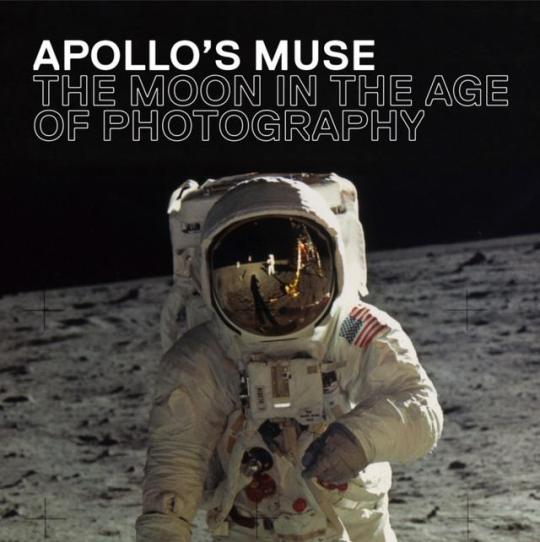
On July 20, 1969, 500 million viewers around the world watched the first moon landing photo uploaded by the American astronauts from the moon. The images helped humans remember this very historical moment in their unique way. The limit of human vision was pushed. To the new dimension.

▲ El Meyers, "Le Voyage dans la lune" film excerpt, 1902
This "moon landing"-themed film pioneered the sci-fi film, which made the film a platform for fantasy and a tool for entertainment. This year's exhibition in the West, which commemorated the 50th anniversary of Apollo's moon landing, almost all showed the film.
Another typical exhibition is the museum of the moon. The Moon Museum is an art installation project for global tours. British artist Luke Jerram replicates the moon at a ratio of 1:500,000. Through the image of NASA, he displays every corner and crack of the moon's surface on an internally illuminated 23-foot diameter sphere, representing 5 kilometers of the moon per centimeter. As Jerram said in an article: "I hope this project can reproduce a myth, inspire people's doubts and re-engage with the night sky." This installation of more than 30 museums, palaces and landmarks has been popular in Europe and the United States since two years ago. But it is not as simple as a photo location. Its popularity comes from the result of the common emotions, myths and narratives of human beings. When you stand in front of this huge moon, it seems to be surrounded and impacted by the charm of the vast universe.
https://www.youtube.com/watch?v=dX6HrVdtC7A
OLALA 2018-The Museum of the Moon, Luke Jerram
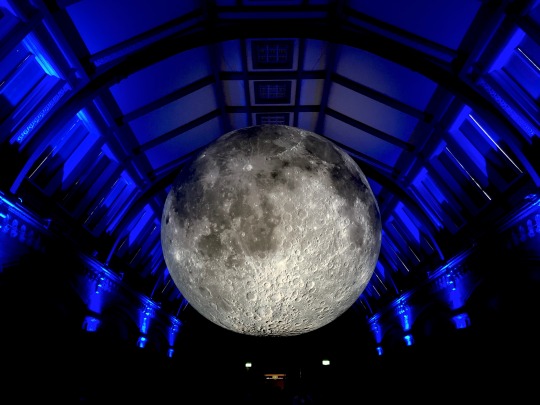
Moon Museum, British National History Museum, London
As it travels from one place to another, it will collect new musical compositions and continue to collect personal reactions, stories and myths, as well as highlight the latest lunar science. The device combines a moon image, moonlight and surround sound, created by British composer Dan Jones. From the beginning of human history, the moon has become a "cultural mirror" of our way of faith, understanding and observation. For centuries, the moon has been interpreted as a god and a planet. It is used for timing, calendaring, and assisted night navigation. Throughout history, the moon has inspired artists, poets, scientists, writers and musicians all over the world. A round of the moon, a delicate new moon with the sun, or the mysterious dark side of the moon, the faint blue light that evokes people's passion and exploration. Different cultures around the world have their own historical, cultural, scientific and religious relationships with the moon. The Moon Museum allows us to observe and think about cultural differences and similarities around the world and to consider the latest lunar science. The meaning and interpretation of the work will vary depending on where the work is presented. New stories and meanings will be collected through local research on the artwork of each location. (https://my-moon.org/about/)
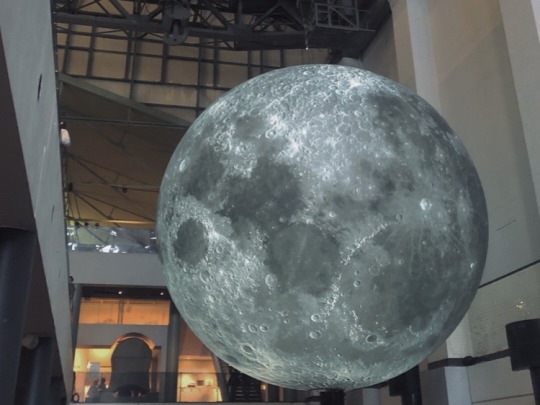
Moon Museum, Powerhouse Museum, Sydney

Moon Museum, Aga Khan Museum, Toronto

Moon Museum, Milano
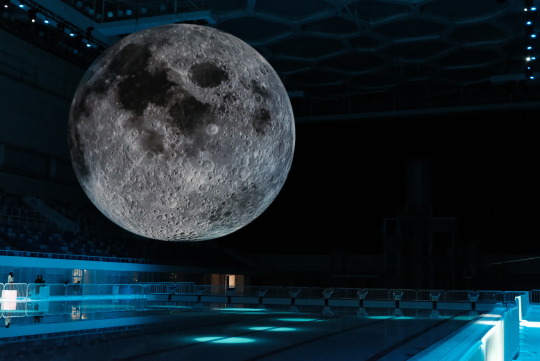
Moon Museum, Water Cube, Beijing
For a long time, human beings have a long-lasting fascination with the fascinating spheres in the sky, so this exhibition shows various paintings, scientific instruments and contemporary art through interactive installations, displays and art installations to explore the moon in human faith and science. And the various roles played in the arts.
Talking back to the meaning of moon exhibition, those exhibitions aim to memorize the 50th anniversary of the first human landing on the moon. In today’s context of the United States’ “returning to the moon”, the establishment of a lunar space station, and other countries competing to explore the moon, people cannot forget the political, scientific, technological, economic, and life-like aspects of Apollo’s manned moon landing on human society. Even the great influence and promotion brought by the spirit.For the time being, the US “Return to the Moon” program will also draw heavily on the experience and technology of the Apollo manned moon landing project. Many of the programs and technologies of the year are not out of date even today. The Apollo manned moon landing project will continue to affect the global influence for many generations and affect generations.

| Celebrate the 50th anniversary of the Apollo 11 moon landing logo. The prominent two letters O nested the Moon and Mars, respectively, meaning that the two planets NASA has explored, from "Apollo" to the moon, to "return to the moon", and then to Mars in the future. The next huge overflight refers to the next era to explore the focus: Mars. Samsung represents the three stars on the Orion belt. This logo was designed by NASA graphic artist Matthew Skins.|
In the fierce space competition between the United States and the Soviet Union in the late 1950s and early 1960s, the Soviet Union successively won several firsts: launching the world's first artificial earth satellite, launching the world's first moon detector, and launching it. The world’s first manned spaceship... The United States deeply feels that this is an extremely serious political issue. Therefore, the United States has been eager to surpass the slogan of the Soviet Union and is determined to show the United States as the world’s number one superpower. Level and national strength.
On May 25, 1961, US President Kennedy announced to the world that he would implement a majestic manned moon landing plan. “I think that our country should achieve the goal of sending people to the moon and returning them safely to Earth before the end of this decade.” Thus, the implementation of the manned mission to the moon in the United States is a political decision. The purpose is to re-establish the technological leadership of the United States in the eyes of the people of the world and to invigorate the spirit of the United States.

| President Kennedy speaks on the "Apollo" project in Congress |
The project is named after the sun god "Apollo". Although it can be seen as an ad hoc plan to compete with the Soviet Union, it is also the first step in human expansion into the solar system. Its purpose is to achieve manned moon landings and human field visits to the moon, for manned planets and Probing for technical preparation.
The Apollo manned moon landing project has greatly stimulated the slow-moving space program in the United States. Various people from all walks of life have offered suggestions, and it took only eight years to get on the moon.

| Apollo 11 Badge |
The success and achievements of the Apollo program have great historical and practical significance.
Politically, it has finally established the United States in a leading position in many aspects of space technology, and has produced a great reputation. In science, it has made humans have the first direct research and understanding of the moon and near-moon space. In terms of technology, many breakthroughs have been made, which not only laid the foundation for the later aerospace program, but also widely used in the national economy.
In engineering management, NASA has thus gained a series of valuable experience in large-scale engineering planning and management. Economically, this is a more controversial issue, but according to the Zeiss report, the “Apollo” plan has increased the US economic growth rate by 2%, the price index by 2%, and created 800,000 employment indicators. The Zeiss report also believes that In 1958, the US national income was 406.2 billion US dollars. In 1968, it reached 864 billion US dollars. In 1970, it increased to 90.46 billion US dollars.
The implementation of the project has led to a large number of high-tech industrial groups such as liquid fuel rockets, microwave radars, remote control operations, radio guidance, ultra-high strength and high temperature resistant synthetic materials, new electronic computers, pharmaceuticals and bioengineering. Later, many technical achievements such as artificial intelligence, robotics and remote control operations of the project were transferred to civilian use, which promoted the overall development and prosperity of science and technology and industry. The benefits of secondary development and application far exceeded the Apollo program itself. Direct economic and social benefits.
In the last 10 years of the 20th century, the United States was able to maintain high-speed and efficient growth, thanks in large part to the thousands of application technology achievements or patent applications in the economic field derived from the Apollo manned moon landing project. The United States is ahead of the world. High-tech, such as information, biology, and new materials, comes from the digestion, optimization, and secondary development of lunar exploration technology.
In the implementation of the Apollo manned moon landing project, in order to cool down and ensure the safety of the astronauts on the moon, the liquid cooling suit was developed. The principle is to use the pump to deliver cold water circulation refrigeration. Later, this technology was directly applied to the army, navy and air force. The working conditions of tankers, submarines and pilots have also reduced the suffering for some special patients. For example, there is a little boy who has scalded scalpel disease and can't dissipate heat through the skin. Therefore, most of his time can only be kept in the air-cooled environment. Many daily activities can't participate. After the liquid cold clothes, he can Go out and play, save from illness and loneliness.
Another popular bar code for shopping pricing is one of the aerospace technology masterpieces that was originally invented by the United States to control the countless components of the Apollo program.

The intensive care unit was one of the important medical advances brought by aerospace technology. It was originally born in response to the Apollo program's need for health testing of astronauts on the moon.

The dried cabbage leaves in instant noodles are the dehydrated vegetables commonly used in aerospace foods. They are used to store, store, and transport excess water in vegetables. The Apollo program first uses this technology to allow astronauts to eat vegetables. Aerospace foods are now widely available in aerospace foods.
All kinds of fashionable sneakers are also the "products" of Apollo's achievements. The "air blow molding" manufacturing technology is derived from the Apollo plan for the production of space suits. At that time, scientists made a complete and uniform thickness. The large-pressure space suit liner invented a method of heating and softening a group of pressure-resistant soft materials, placing them in a mold, and then blowing high-pressure gas into the mold. After that, the sneaker manufacturer found that the process could Quickly and efficiently create a complete upper that is widely used.

In conclusion, human desire for space and resources is growing towards rationality with the advancement of technology. On September 5, 1977, NASA unmanned probe traveler 1 launched into the solar system. Voyager 1 carries a gold-plated bronze record with a diameter of 30 cm, trying to introduce humanity to the extraterrestrial civilization as completely as possible. The album contains 115 pictures of the earth's features, humans, knowledge and solar system celestial bodies; 55 kinds of earth language greetings, beginning with the Aka German used by the Sumerians 6,000 years ago, ending in Chinese dialects; Dogs, birds, trains, and other "voices of the earth"; there are also music from a variety of cultures, including Beethoven's Fifth Symphony, Chinese Guqin "Water", Chuck Berry's rock, African blows Music, the voice of New Guineans, and so on. When astronomer Carl Sagan presided over the compilation of the album content, people's expectations of discovering extraterrestrial civilization seemed to be a little higher and more romantic than now, unlike the calmness of more than 40 years. Today, the urban legendary craze of UFO and alien signs is over, but serious exploration is still in progress.I don't know if we can see the breakthrough in our lifetime. We don't know when humans can really leave the cradle and start the interstellar voyage. We don't know whether the form of life will exceed the range we are familiar with, or even whether human cognition is enough to understand the universe and itself. The only thing that can be determined at the moment is that as long as the human species still exists, there will always be some members who will be the pioneers of travel, extending the footprints of human footprints and thinking to farther places.
1 note
·
View note
Text
Sailor Senshi and Shitennou Romance Essay -Introduction
(Warning. Due to the way Tumblr Mobile is working for me there may not be a read more on the mobile version of this essay. I do have one up on the computer version of the program, but apologies for anyone reading this on mobile. I’m still trying to work out how to make this work better for the readers there. I may have to eventually set it up where there’s a mobile only blog…but until then…yeah…still working this all out. )
For those who don’t care about the above, skip down to the info below the picture.

Where to even being with this. I suppose I should start as to why I would even do an analysis on the romances here, given that they were very limited in scope of the story proper. We only really got a quasi-detailed account of Kunzite and Venus from Sailor V and the main Sailor Moon Manga. Yet, it seemed to be that, even despite not being able to write about the romance in her work, (due to either her own issues with writing long works. (Something that Ms. Takauchi has mentioned in interviews before), or the story proper not being able to facilitate a longer narrative for the romantic structure (it’s a Tokusatsu after all)), Ms. Takauchi still seemed to want to have those romances in some way. If you look at her artwork and some later stories –such as Casablanca Lilies and the short story about Sailor Moon’s other child (which is non cannon) –we know that she does have focus on the girls love lives.
For me the most interesting aspect about these possible romances is the way it connects to the older stories from not only the west with Selena and Endymion, which formed the bases of the romance with Usagi and Mamoru, but also the Eastern tales of lost romance. Specifically the story of Tanabata Festival, Princess Kaguya, and possibly the story of the crane wife (usually it has a story with a celestial being falling in love with a mortal man). The reason I’m equating them to these stories is how they end up being both sad yet romantic in some ways and in some cases there are some aspects of a happy ending, within the context of how the Japanese see a happy ending.
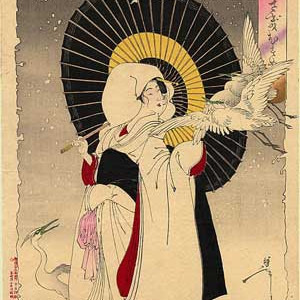
For the story of the Crane wife, normally it tells of how a young farmer discovered a woman bathing in a pond and he fell in love with her. He discovered she had a cloak that was magic and took it with him hiding it from her after the woman has fallen in love with him. Eventually after a while of them being married and her having a child with the man, the woman becomes more and more depressed over something. Then one day, either she or her child discovers the robes and changes back leaving the man and the child. Or the man never knew she was a crane or a celestial being and he discovers this one night after coming in on her wearing her robes, and because of this she has to leave his side and return home.
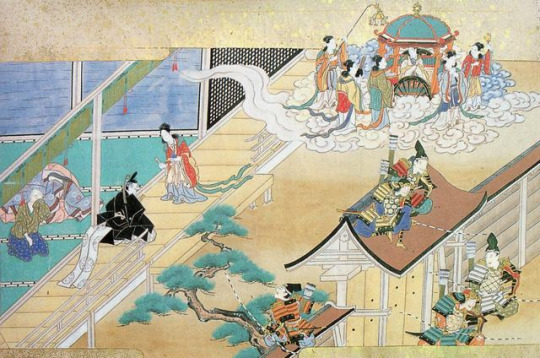
On the flip side is the Princess Kaguya story where she came to earth to learn to be a human, but didn’t want to fall in love, and eventually returns to the moon against her will mostly because the moon goddess missed her.
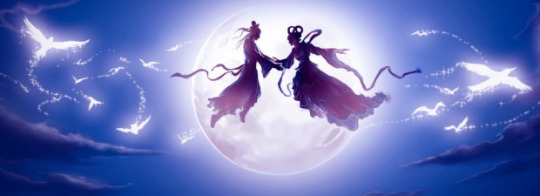
Finally, you have the story of Tanabata, which is based on an older Chinese story of Qixi. The story goes something like this, there’s a princess named Orihime who is the daughter of the Sky King Tentei and she used to weave clothing on the banks of the Milky way river for her father. So the princess was sad that she could not fall in love because she was always making her dad clothing. Her dad, feeling sorry for her, decided to invite a boy that he knew named Hikoboshi, who was a cowherd that worked on the other side of the river. The two met and fell in love and married. However because they got married and were together all the time both neglected their work, so Tentei ended up splitting them apart. This eventually led to Orihime begging her father to allow them to be together. Tentei was so moved by his daughter’s tears and words that he agreed to let them meet once a year on the 7th day of the 7th month as long as she finished her weaving. As such, the two were going to meet but there was no bridge, but a bunch of magpies created one for her so that she could cross over to him and be happy for a while.
Oddly enough, the story was used in a Chibiusa Picture Diary story, but that’s not where the importance lies.
So how do these three stories fit into the idea of the knights and the Scouts and their romance and why? It’s not uncommon in Japan to rely upon older stories for crafting new stories for Shojo writers. Typically, it can come from the west or the east, but a lot of ideas from the idea of true love tends to derive from older stories and legends that have been passed on, much like western fairytales, and in the case of Sailor moon, a lot of the idea of legends are pulled into a new form. As I mentioned the three stories are an influence in the work, and there are strong hints through Usagi and Mamoru’s romance about their relationship hinting at these three works, along with the Selena story.
You have the idea of the Prince and Princess being from worlds apart, which connect to the legends surrounding the Crane Wife, and partly the tale of Kaguya. More frequently, you have the fact that the two end up with each other for a while, but the celestial being is normally not supposed to be with a mortal human. The Tanabata legend is deeply invested in the story as the two lovers that we see are not only from different places, thus split by the space between them, but their world is pulled apart by the actions of others. In the case of Orihimi and Hikoboshi (Vega and Altair), we see her father break them up via the river that is the Milky way, in the case of Serenity and Endymion, it’s the actions of Queen Beryl that split them apart.
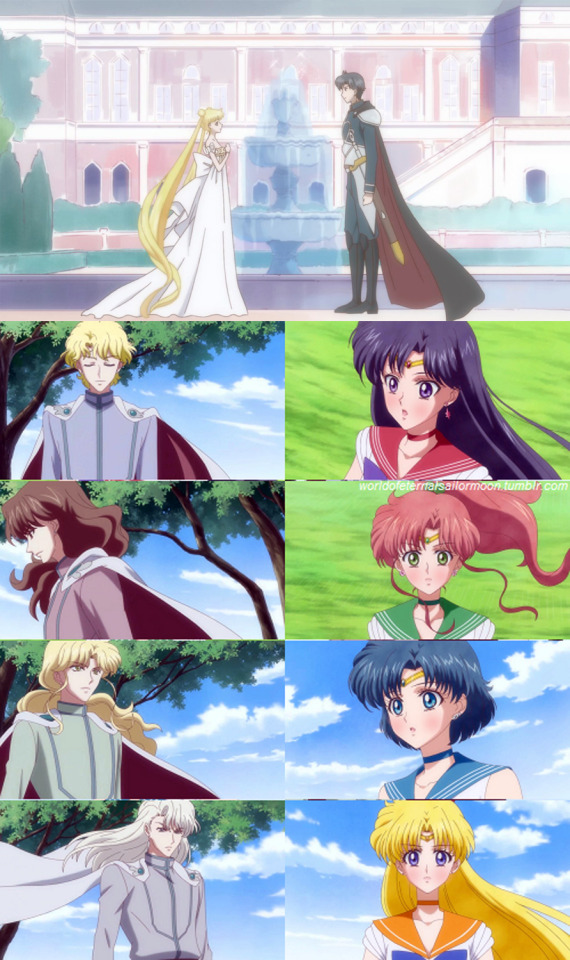
This can also correlate to the other girls in various ways, since we see that they too met with the Knights and fell in love, as per Venus explaining. Which brings up the idea that Ms. Takauchi probably wasn’t just thinking about how the tale pertained to just one person, but how it could affect others who met too and fell in love. This also I have to say brings us to the idea of the Tokusatsu aspect of the series. Most notable is that the Sentai at the time before Sailor moon was created did have an additional soap opera like subplot, and typically revolved around the main lead and either a girl fiend that they had to deal with, or another member of the team was the love interest. I get the feeling that Ms. Takuchi was wondering what would happen if all the members of a team were in love and got to deal with relationships as typically the other members of the five man band Sentai (Ranger) team were only there for support.
If we go on the idea that the groups were to be reunited as one unit either as a heart-breaking situation where they were parted later on. Or as a possible happy ending where they stood as a group against the darkness from evil then one could assume that this could be very much like the Tanabata legend, with the idea that each of the girls would go on a journey to connect with their own Hikoboshi. This idea could also be connected to the aspect of a team up deal going on, which happened in Sentai (not as much as now but it did happen in the 90s) where either a former team would pair up with the new group, or some of the villains would side with the heroes to deal with a bigger bad. Throw in there the fact that dramatic stories typically were part of the takarazuka review, something which Ms. Takuchi drew inspiration from and you have an easy conception of how that could lead to her wanting to explore not only the relationships of her main lovers. But, also how their helpers could benefit or grow from a relationship with someone who either was different from them, or similar in ways to understand their situations. And in the case of the Star crossed Lovers, how they could be ripped apart in a way that could affect them enough to try to save their former allies/friends/lovers.
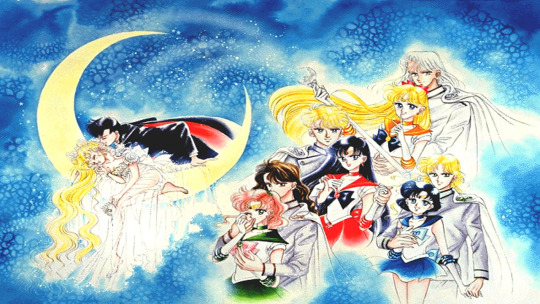
When the first Art book came out for Sailor Moon, fans were a bit surprised, or not surprised, to discover the image of Sailor Moon with Tuxedo Mask, and alongside them the Senshi with the Shitennou, as former guards of the Prince. And what’s really interesting is how she chose to set them up on the page and the way they look, particularly their body language.
So to start out with you have the main couple of Usagi and Mamoru. Now this one could be explained very easily but there’s more to the positions. Every artist finds a position that they like and nothing is done without taking into account how the image is going to look and turn out.
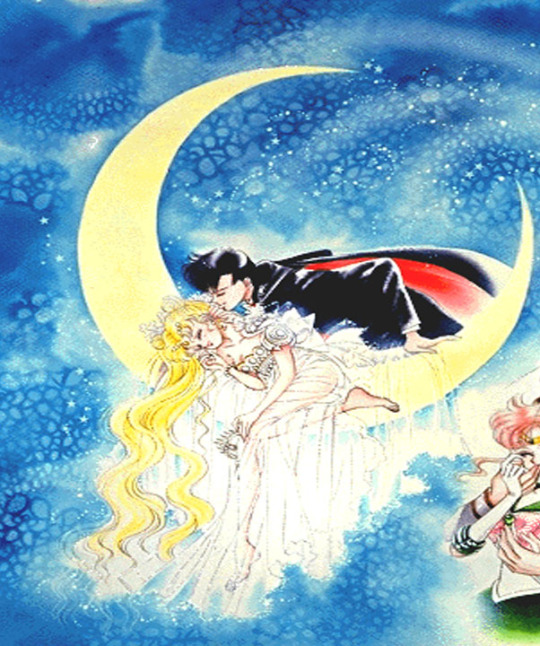
So you have Usagi (or the Princess) sleeping on the moon, curled up almost childlike in her innocence, holding a crown as Mamoru leans over, hand on the side of the moon, pushing her hair back and leaning in for a kiss.
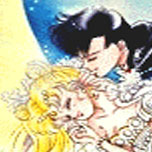
The thing that stands out for me in this moment is the fact that she is resting like a kid in a bed, unaware of him leaning in for the kiss, indicating that she’s very innocent and pure in all this, and the kiss itself is going for her cheek rather than her lips, showing a very chaste moment. And there’s a reason for that, given that the readers of this series were mostly younger girls the idea of a more innocent love would appeal to them, and that links back to the story of Orihime and Hikoboshi and how their love was seen as far more innocent in nature.
Also her sleeping beauty like pose would imply that this is dream like in nature, and very much a fairy tale, so you have that going on there as well. I really don’t want to get into the whole history of Sleeping beauty here because there’s a LOT to dissect with that, but the over all tone of the moment is something pure that is happening between them.

We also see her holding her crown, which she never wears in the series proper, but it’s to indicate that she is seen as a royal and that at the moment she isn’t being the princess here, and it’s a moment of respite that she’s taking. Mamoru stealing a kiss is showing that he’s invested in her and that he finds her resting like this cute and wants to show her affection for it.

From the top we have Venus and Kunzite, and automatically you can see his hands are around her waist holding her close. This is typically seen as a reverse hug and is used to show affection and trust between two partners. It’s interesting that they have the most intimate, or second most intimate position in the group of guardians. Venus for her part is holding a staff, and has her finger to her lips, indicating quiet or a secret. Honestly to me it could play as her saying “Shhh, the princess is asleep” or the idea that the romances are a secret thing, which ties in with part of the Chinese version of the Tanabata myth where the marriage between the two lovers was done outside of the view of the gods.
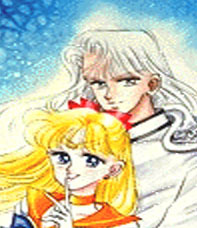
The fact that she’s leaning into him, and he’s resting his chin, lower cheek area, on her head, shows they have a comfort with one another. He’s allowing her to lean on him for support and she feels close enough to him to let him rest his head on her, showing a warmth and affection between them that probably is very strong and understanding. And it makes sense given their roles as leaders as well as their titles. Venus being the guardian of love and beauty (as well as light) and Kunzite being the Knight of Purity (Virtue) and Affection, both having an understanding of deeper love and devotion, and loyalty.

I should note here that his hands are wrapped around her waist and interlocking showing that he has not only a protective grip on her, but one that is keeping her close to him, showing a lot more passion and ardor for her then we may see in his face. He’s enjoying having her locked up next to him, and his face shows this.
The way that they’re set up at least tells me in this case that their relationship was certainly more of a public display of attraction and affection, given that Kunzite was shown to have teased her several times in the manga and the implication there was he was attracted to what he saw in her. Clearly Venus could see both of his sides, and the idea that he was very much a noble prince like figure himself must have caught her attention.
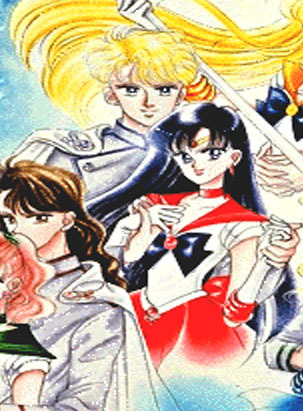
On the other hand, you have the next one down being Mars and Jadeite, and their position. While Venus and Kunzite seem way more casual, Jadeite and Mars instead have a very regal demeanor to them. Both are smiling forward with Mars leaning back onto Jadeite’s arm, which is supporting her. Glancing to the right side of the picture his hand is cupping hers, and this is something that is kind of different in what it means in body language.
This gesture is more or less a passive hand hold, with a bit of a “my lady” gesture thrown in there. What does that mean? Well Passive hand holds usually indicate that neither one of you is clingy in the relationship, meaning that there’s a great deal of trust there and a peace between the partners that neither feels that they have to be aggressive or dominate in a traditional way. It also indicates that there’s ground rules that were set and boundaries that are in play between them. It’s also seen as a tender sweet sort of hand hold, indicating that there’s a closeness, but one that doesn’t have to be showy in nature or inappropriate affection.
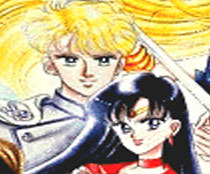
Her smile is soft and delicate, not trying to be outwardly showy, while his is calm and kind and you can see it in his eyes that he’s glad to be with her at the moment and happy about it. Again, as I said in my commentary about him, Jadeite is probably the most friendly of the group, and his smile shows a warmth to his face, clear that he’s devoted to the woman that he has next to him.
And that fits right into Jadeite and Mars in that both are calm people who prefer a peaceful situation, and probably neither feels that they have to be very vocal in their feelings as both are spiritual on different levels and, given Mars role in the scouts, it’s not surprising that she wouldn’t show her feelings loudly. What’s also interesting is that that the My Lady hand hold is one of the most regale, and usually used for wedding pictures and the like. Typically it shows that a relationship is vital, firm and has equal protectiveness from both partners.
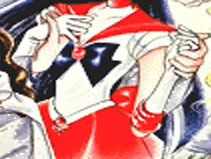
Mars hand is cupped in his in a way that shows it looking smaller, giving her a dainty like figure, but at the same time it’s in a loose fist so it shows a strength there as well, and Jadeite’s hand is curved around it, showing that he’s supporting that strength. This hand hold is seen as showing a very healthy relationship, a bond of respect, and that the romance is founded on trust and adoration. It’s interesting to note that Jadeite is supporting her on that arm as well, showing an almost half hug, and indicating that he’s got her back if she ever needs the help on something.
On the opposite hand you have what one might call a palm facing down hold. It’s an interesting way of putting their hands here and telling of a lot of things. For one thing typically it’s the guy who’s holding the girl’s hand with the palm down, but in the case, it’s Mars that has the more dominate stance here, showing that she’s protective of him, and because their hands are lightly touching this means that she’s also gentle in her actions. It also shows she’s the one that has the more dominant role in the relationship, which makes sense seeing as her powers of fire probably trump his ice powers. It also shows a bit of independence between them and that both have a strong trust in one another that they don’t always have to be joined at the hip. Given both their personalities, it’s not a surprise that Mars and Jadeite would be the least likely to outwardly show their love in large displays, but rather softer quieter moments.

From the regal to the more flirty in nature, looking down from Mars and Jadeite you see Jupiter and Nephrite. And this is a couple that probably has more moments of displays of affection then the others outright, even Kunzite and Venus. You might be wondering why I would think that, well their stance says a lot about their relationship.

To start with you have Jupiter, like Venus, leaning into Nephrite, and pressing against his chest, meaning that she feels close enough to him to want to be near him and probably they have a very warm affection towards one another. His head is tilted down into her ponytail, and normally when someone does that they’re indicating that they’re showing a nurturing and intimate gesture that shows affection and protectiveness, and a close emotional bond that indicates the person is there for the other. Jupiter for her part is winking and has his hand up to her lips kissing it. It’s all very intimate in nature and for a reason. Both characters are comforters in their own way as Jupiter is the most sensitive and understanding when it comes to emotions of others around her, and Nephrite is the Knight of Comfort.
Looking at them it’s an interesting set up here. You have Nephrite in a pose that says he’s trusting and comforting Jupiter, letting her lean on him, and knowing that he’s here to help her out. At the same time her leaning against him tells him that she cares deeply about him and enjoys being with him. She’s even winking, showing that they’re keeping something secret together and it’s almost like she’s teasing the reader in some way to learn more about their relationship.

The hands are an interesting story too. He’s brought her hand up to her heart and is holding it there. This could mean a lot of things, but the most likely is that it’s showing a sign of protection, strong bonds, and a deep attraction, indicating that they both are connected by their heart and desire to use that part of themselves to be with those that they love and care about. There is a huge amount of intimacy with that motion, and showing that there’s a lot of affection that drives these two as a couple. The fact that she trusts him enough to be that close to her body in a physical way indicates via body language that there’s a deeper connection between the two. It’s also seen as a romantic gesture.
On the other hand you have Jupiter kissing his fingers while he’s passively holding up his hand to her in an upward movement which means that to Nephrite he has a lot of trust in her and is willing to be a more passive gentle person around her, while she’s more playful. Kissing a hand shows there’s admiration, tenderness, and a desire for love. There’s also trust on the part of the giver, and a sense of respect, adoration, kindness, and in this case a playful flirty-ness that shows that the two are more likely to show displays of affection frequently and willingly.
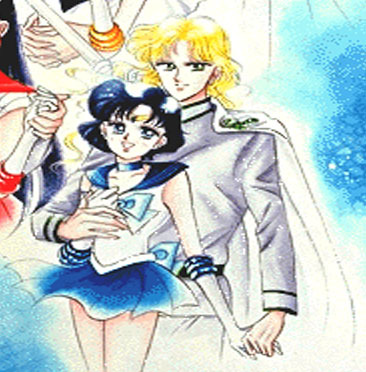
When you look to the right of Nephrite and Jupiter you come across the couple that I think has the most interesting relationship, Mercury and Zoisite. It’s a very different stance then the other couples. Whereas Jupiter and Venus are leaning on their partners, and Mars is on Jadeite’s arm. Mercury while leaning on one side of Zoisite, is partly being hugged by him with one arm, at the same time he has his hand loosely around her wrist as she holds it up, pulling him closer to her, and on their opposite hands, which are straight out, his hand is firmly in the other in an almost princely like pose.

What stands out for me in this case, after looking up about the hand holding positions, is how actually intimate and passionate these gestures actually are for these two characters. With their faces it’s an interesting juxtaposition. Mercury doesn’t smile that brightly often, and when she does you know she’s happy about something. Whereas Zoisite hardly ever seems to smile, and the fact that his eyes show a smile to them while he’s holding her shows that he’s happy in this moment. Not to mention that she’s tipping her head towards him indicating that she feels comfortable and safe with him and trusting too boot.

Their hands are also interesting, the first pair on the left is a sort of wrist hold. Zoisite has his arm over her in a protective way, and is lightly holding her wrist. This normally indicates a passionate and more intimate relationship, one where the partners need to be around one another. It also shows an urgency and trust between them in a different way. With both being a bit distant when it comes to showing off emotions in high ways, and reliant on their smarts, is it any wonder that their bodies show more about their feelings then what they say. The way Zoisite has his hand over her shows he’s protective of her, and needs to keep her close to him.
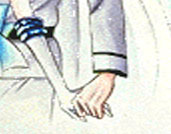
To the right her hand is being grasped firmly in his, in a “My lady” like firm hold. Usually this indicates some possessiveness, but also a healthy one based on trust and honor, as well as respect and admiration. It also shows a desire to stay with the person, given the firmness of the grip and the fact that he has his hand over hers also indicates he’s very protective of her and is serious about his feelings towards her.
Mercury’s smile is all you need to see she’s happy and that she enjoys being with him.
I’ll end the intro here, but my plan is to go deeper into these four relationships if I can and think about how they worked and could work in the modern age.
#sailor moon#sailor moon crystal#smc#smc season 1#senshi x shitennou#shitennou x senshi#shitennou#shitennou analysis#mercury x zoisite#zoisite x mercury#ami x zoisite#zoisite x ami#sailor mercruy#zoisite#knight of purification and healing#mars x jadeite#jadeite x mars#rei x jadeite#jadeite x rei#ami mizuno#rei hino#sailor mars#jadeite#knight of patience and harmony#jupiter x nephrite#nephrite x jupiter#nephrite x makoto#makoto x nephrite#makoto kino#sailor jupiter
555 notes
·
View notes
Text
Elizabeth Midford, Dull Swords: Part 1, Building a fight scene
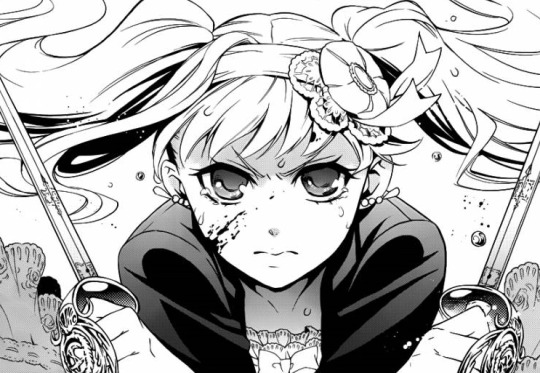
Despite Black Butler’s massive popularity as an anime and manga, by film standards the movie falls far beyond what the fandom would have expected. The first live action was received with heavy negative criticism and it would seem that ‘Book of the Atlantic’ fell somewhat in the same way. In less than two weeks of the Japanese release and the three days of US release the film earned less than $5,000,000 combined - in comparison, the highest grossing film of the year, ‘Detective Conan: Crimson Love Letter’ earned $11,749,652 alone on its opening weekend.
These two movies can’t be compared, due to the huge differences in the plots and narratives yet… Black Butler’s production team could learn a thing or two. The greatest fault in ‘BOTA’ was its “so-so” action, that was also said to be a fault in the previous movie. Knowing this, I’d like to analyse Elizabeth’s famous fight scene and look into why the series has been known for poor action scenes despite the great action depicted in the manga.
Long post so the rest is under the cut.
For anyone who would like to watch the fight as they read the analysis, the full fight is linked here: https://www.youtube.com/watch?v=5LfH_MLe7jI
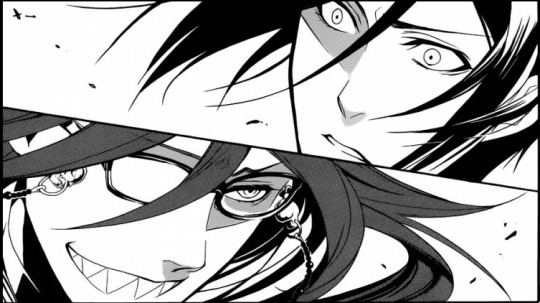
An important thing to know about writing fight scenes is that a fight alone is not interesting. It is the weight behind that fight that makes things interesting. Superheroes fight to save the world and villains fight to accomplish their own goals. The start of this fight is not interesting because it begins with Grell wanting to fight simply for the sake of fighting - this is just Grell’s character. We know that one of her main roles in the series is to block Ciel and Sebastian from attaining their goal. Our protagonists, Ciel, Sebastian and Elizabeth want to avoid this fight instead, giving us more of a reason as to why this fight should be done with as soon as possible. This fight does however have one purpose - leading up to Elizabeth’s exposition as the swordswoman she is.

When creating a fight scene, interest is added by raising the stakes - the more danger there is of losing something, the greater the emotional payoff and tension - each fight should be a gamble that makes us feel that the characters we root for have to win. Even if they’re bound to lose, the chance that they should win should at least tempt us. Toboso changes this with how she portrays Sebastian.
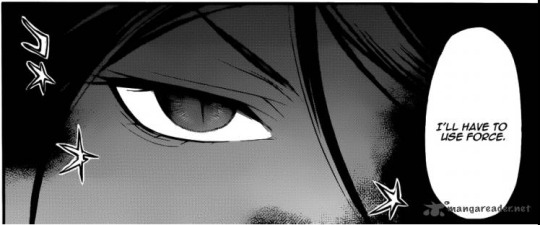
Usually when Sebastian engages in battle, we expect him to win every fight, since he’s put forward as this amazing force that always succeeds his tasks. Fighting against two reapers should mean nothing to him. Yet, the extra baggage of protecting two children raises a problem. By separating them, Toboso then creates the possibility of “only one can survive” - Sebastian would choose Ciel in priority over Elizabeth. In this instance, we start to fear that Elizabeth is in danger.

Given that Ciel would “do anything to protect his fiancee”, we trust that he’ll be able to reach out to Elizabeth in her time of need. With an injured leg, Ciel is then rendered useless in his state. The fact that Ciel is pictured as further away from Elizabeth in the manga, shown by how Ciel is not in the frame, highlights her vulnerability against the Dolls that are drawn enormously in comparison to her size. Not only is he unable to protect her, but he’s unable to protect himself if Sebastian can’t shake the reapers off of him.

In the film, Ciel is pictured relatively close to her, removing this aspect of fear for Elizabeth’s state. The film makes it seem as if either one of them was able to stand, they could make it to each other in less than a few seconds. Since the idea that Ciel will always protect Elizabeth has been referred to in the film numerous times already, we believe that if she makes it to him he’ll do what he can to protect her. While one may argue that this puts Ciel in danger as well, Sebastian could come in soon and save the both of them - the distance between them in the manga is important in exaggerating that the matter of a second could literally result in Elizabeth’s death.
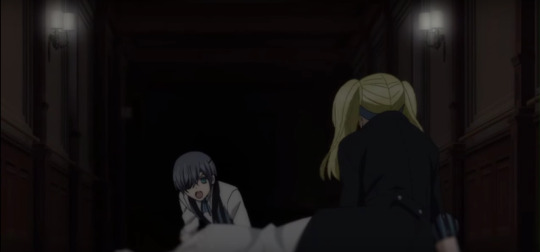
The manga shows her sluggish movements to get up while Ciel calls out to her quite well, since the distance between her and the Bizarre Dolls is much closer to make it seem as if they’re closer to grabbing her than they really are.

The fact that when the camera cuts to Elizabeth as she’s already propped herself up removes the aspect of vulnerability that’s shown in the manga. The way that the film only shows their legs in the foreground does play with the whole compositing of the scene, making them look larger than they are, but it ends up losing the sense of urgency that the manga had as they seem close enough to touch her.

In the manga, we don’t see Ciel whip out his gun and cut straight to him shooting. This already is far more effective than how in the film we see him pull the gun out (rather slowly considering the situation) and then shoot. This panel is effective as it shows the speed of his fire - he wants to kill them as fast as he can and the futility in it shows it. The film only shows the first shot then switches to focus on Ciel shooting, rather than the targets he’s aiming at. To improve this, perhaps a shot showing his perspective as he watches Elizabeth try to scramble away with his shaking hands in the frame as shoots would be more effective.
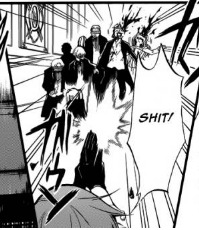
Not to mention that as the first Doll lunges to bite Elizabeth, for some reason it gets launched sideways instead of being fired back by the force of Ciel’s gun. If you slow it down enough it even looks as if the image of the Doll being shot was just dragged across the screen instead of actually flopping from the force of the shot.

The next image of Ciel shooting is relatively basic. The team might as well have just made a gif of Ciel shooting those three shots or so and it could look the same. There lacks any variation in those few moments that we see. Comparatively, the single image in the manga of Ciel shooting at the horde without showing the Dolls being killed right before Elizabeth is much more effective. It’s made evident in the manga that this boy is in full panic as we see the large group towering over Elizabeth, once again with the distance exaggerated as much smaller to create the sense of danger. The open space around Ciel in the film also takes away from how much tension there was in the manga - while you can argue that this shows his isolation, having this sort of shot in this perspective loses the image of danger that threatens Elizabeth.
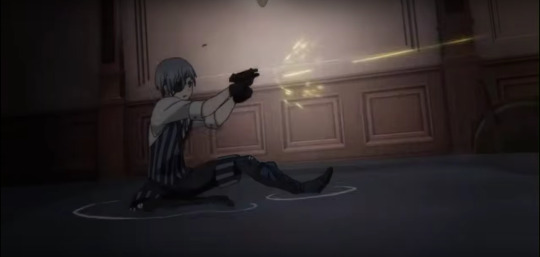
In the manga, we truly see Ciel’s terror as he realises that his gun is out of bullets because of the closeness of the panel and the tightness of the frame which follows the positioning of his arms. Not to mention how the gun is so centred in the panel, showing how it’s the centre of his focus.

Ciel’s expression in the manga shows fear by a wider mouth and the more dramatic shading over his face. In the film, his expression is much more frustrated. This choice is obviously understandable. It’s a pretty shot and all, but it does take away from some of the drama because the position is far less dynamic.
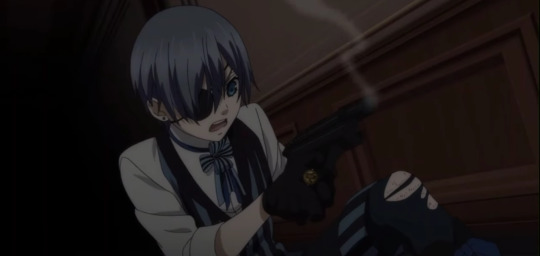
The sequence of events leading up to Elizabeth’s reveal changes, which arguably makes it less effective. In the manga, switching perspectives between Sebastian, Elizabeth and Ciel adds to the chaotic nature of this scene. Everyone has different opponents but they all need to survive. Seeing Sebastian dash towards Elizabeth emphasises that even he might not be able to save her, shown by how close the Dolls hands are to Elizabeth. The manga is able to use action lines to show and highlight the focal point of each panel. Such a thing would be harder to animate. Though used heavily in sports anime like ‘Haikyuu’ and ‘Ballroom e Youkoso’, in a setting such a ‘Black Butler’ which tries for elegant and refined style, rather than artistic interpretation, these sort of lines don’t fit as well.
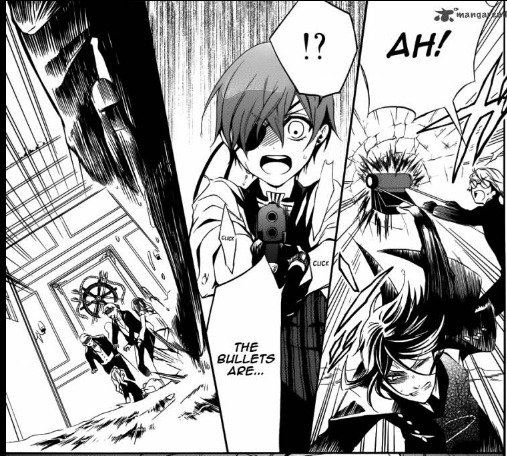
Arguably, the most important part for this build-up is how Ciel reacts to believing his fiancee is about to die before his eyes. The order of focus is especially important in this. In the film, Elizabeth starts to talk, turning around just as the feet of the Dolls come into frame. This is a relatively good shot. Here, the director chose to show Elizabeth’s vulnerability more by emphasising the height disadvantage. On the floor, she lacks the escape means. In the manga, she may be sitting down, but the danger is shown in the form of hands. What the film shows is the immense force that is about to strike down on top of her. The manga does this as well, but I would give this a pass.

On the other hand, the manga highlights the panic that the both of them feel in this situation. In the film, Elizabeth is already smiling as she talks to Ciel, and then we see Ciel’s reaction, rather than how Ciel in the manga realises first and then we see Elizabeth’s struggle to hold in her tears. The film chose to show Elizabeth in a state of acceptance, which again is very powerful, making the audience think that she’s resigned to her death.
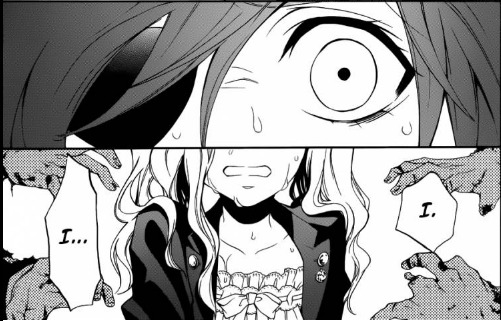
Ciel’s expression in the film is much more akin to anger, a frustration in how he’s unable to save her. The manga’s choice shows Ciel in absolute fear - the lack of colour serves to dramatise this as well. Black Butler is known for beautiful eyes and just zooming in on the empty look of Ciel’s eyes shows the rawness of his fear. His gentler brow also serves towards showing more fear than the sharper brow in the film. This, coupled with the echoed gasp and sound effect, adds to the hollow feeling that Ciel would feel upon realising the possible fate of Elizabeth.
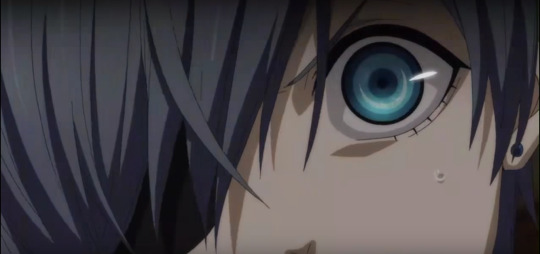
Once again, the lack of colour in the manga adds to the dramatic panic felt in this scene. During the entire scene, Elizabeth’s blazer was coloured black, as well as her eyelashes - pretty much everything has been turned to greys. As she cries over how she can’t be cute anymore, the softened lines serve to show her in the last angelic moment that she may well have. At this point, it’s hard to tell what are water droplets and what are tears as they run down her face. Her innocence is also highlighted by lighter eyes and shaded cheeks and lips in contrast to her tangled mess of hair. This is the last image that Ciel may see of his beautiful feminine fiancee.
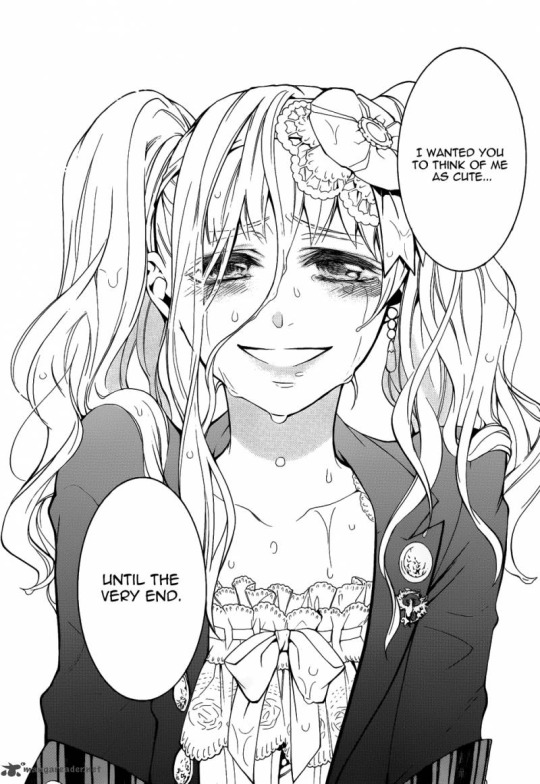
I have less complaints about the image of her in the film. The camera panning up to her crying face emphasises how delicate she is while also keeping the Dolls in the background to keep their threat important. There’s far less detail and her eyes are drawn wonkily, but at least they tried to make this dramatic with the camera movement.

Sebastian finally manages to escape Ronald with simple movements, but that can be forgiven since he isn’t the focal point. Instead, we have the image of him running to save Elizabeth, but all that can be seen of her is her dress between the legs of the Dolls. At this point, the film tells you that it’s all over for her.
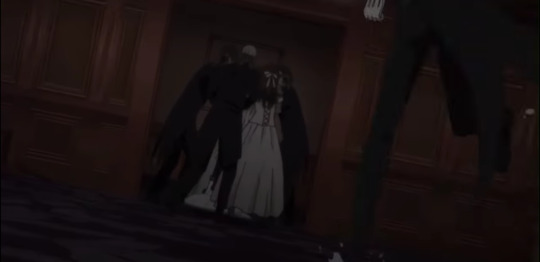
I don’t want to pick up on this, but the way that Sebastian runs here makes me think of the spider gif. It really is a downer to what is a good scene but it had to be said. If this gif doesn’t work when I post it I’ll start crying.

Another flaw I’d point out would be Ciel’s final reach out to Elizabeth. The way this is done in the film feels far too smooth, rather than carnal and desperate - how one would normally react in absolute panic. It’s more like a dramatic flourish that someone would do in a high school play. Of course, his expression of panic is still great. Wide mouthed in a choked/silent scream. If this was animated with a greater sense of urgency, there’d be less of a problem here.
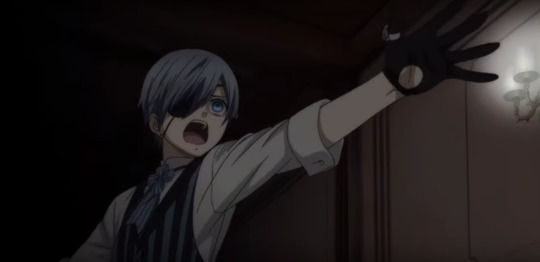
Frame tightness is especially important for the drama of this scene - the manga frame is tight and barely shows Ciel’s full face. This can symbolise how trapped he feels in not being able to do anything. His under eyes are also heavily shaded to show his distress. The open spaces and use of the background feels inappropriate for the close seriousness of the situation. The manga also showcases a look with greater desperation as we see how things are from Elizabeth’s eyes - her fiance screaming for her is the last image that she’d see.

The fact that we see Elizabeth once again as the shadows of the Dolls close up on her is a really good directorial choice. Here the camera’s closeness to Elizabeth’s form works. It almost feels as if she’s saying goodbye to her audience instead, the tighter frame making us form a more personal connection with her, making up for the lesser emotion that Ciel was drawn in beforehand. In opposition to the reactions of Ciel and Sebastian who see that they’re too late in the manga, having Elizabeth listen as her fiancee screams her name in darkness is really well done.

The blackness that fills the screen is just as effective as in the manga to make one think that Elizabeth’s finally been killed. Letting this ring for two seconds gives the audience a chance to think that a death really has occurred. For an audience member who hasn’t read the manga, this would be effective enough to make them think for a second that she’s gone. These few seconds are good and there’s little I would change and I’m glad that the director actually chose to do this. This blackness serves as an equivalent to the page turn and makes it even more surprising when we realise what happens next.
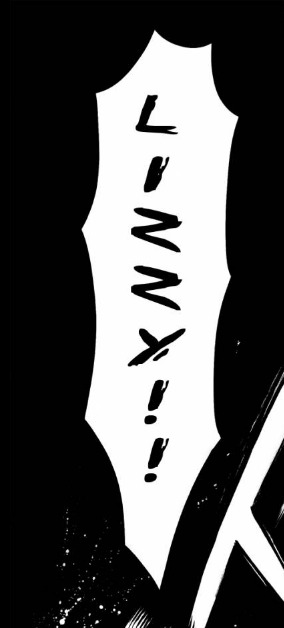
As pernickety as this analysis has gotten over the build up, it’s important to look at it because this is how fights are built up. You don’t start out in any martial arts match with the massive axe kicks and what not. Tension is built up in every fight, whether an official match or in a fictional setting, by the fighters raring up to the bigger scenes instead of coming out with them straight away. Toboso wrote the build up to Elizabeth’s revelation well, which is why this had so much of a reaction for Japanese readers - far greater than Grell’s reintroduction.
Now, despite all that we’ve looked in to so far… we’ve only scraped six or so pages - 30 seconds if you want to talk about it in the films terms. You can see clearly that there are some great points that the film has done well to adapt the manga. It can also be seen that there are some areas of the film which are “so-so” because it lacks the same depth that the manga does.
I’d love to hear your thoughts on this scene alone. I will be getting to the rest of the fight direction, where I believe things start to decline, but I can’t give too much away right now.
#black butler#kuroshitsuji#elizabeth midford#ciel phantomhive#sebastian michaelis#about black butler tag#mod sen
80 notes
·
View notes
Text
I went to the Museum of the Bible
Okay, buckle in, because this is gonna be kind of a lengthy post. My mom got free tickets to the highly controversial new Museum of the Bible in DC and I, with heavy misgivings, decided to come along and see what was up. I have to say, I thought it was a lot better than I expected, though I am still suspicious and cynical of several aspects of the place. So here is my detailed review! Here's what you need to know about the museum first: 1. It was founded and funded by Steve Green, the President of Hobby Lobby, aka the company that went to the Supreme Court because they didn't want to cover employees' birth control, saying it went against their religious beliefs. 2. He was also fined $3 million for smuggling artifacts from Iraq (which did not appear in the museum's collection). 3. The museum is technically non-sectarian (though with a Protestant bias), and does not address hot-button issues like evolution/creationism, abortion, LGBTQ+ rights, or how the Bible "should" be interpreted. Its galleries include tellings of the stories from the Bible, the history of the compilation and transmission/translation of the Bible, and the impact of the Bible on history and culture. It always hints at a Christian interpretation but does not outright evangelize. Some people may find this claimed non-political and nonsectarian interpretation more insidious than an outright Christian oriented museum. 4. The museum is free, but with a suggested donation. I would personally not suggest donating anything if you're interested in checking it out so as not to put money in the Hobby Lobby Guy's pockets, but that's just me. Now, I have to address my own personal biases. I am a Protestant Christian (United Methodist, to be specific), but I'm also strongly opposed to what constitutes contemporary "American Christian culture." I'm a believer not only in God but in human rights, evidence-based science/evolution, separation of church and state, charity, equality, and empathy. To me, these values are compatible with studying Jesus' teachings, and I'm deeply critical of people who use Christianity to justify selfish and narrowminded decisions. I also am an elementary-age Sunday school teacher who likes to emphasize the importance of Biblical literacy in self-professed Christians, which this museum champions (you'd be amazed how many Christians aren't actually familiar with the Bible), and in studying not only the stories, but the themes and lessons behind them (which this museum does not do. It allows guests the freedom to interpret the material according to their own beliefs- again, some might like this and some might dislike it). This museum is huge. We were there for about five hours and still didn't see everything. It was also absolutely PACKED with guests. The line to get in snaked down the block, and there were some long lines to get into the "hottest ticket" exhibits. We started off our day in the most popular, multi-media exhibit, The Hebrew Bible, which is a mix of videos and walk-through visuals with exciting lighting, animation, and voiceover, telling the narrative of major Old Testament stories. This exhibit is a pure storytelling "experience" and does not display any artifacts or purport to be a factual account, which I actually love because it is not claiming that all of these accounts are literally true or trying to show historical evidence. It's a little cheesy but less cheesy than you might expect- it feels like an elegant Disney World attraction but with a more artistic and slightly more abstract style. I especially liked the burning bush (the voice of God was represented as multiple voices in unison, at least one of them female), the white room full of rainbow light after the ark, the Red Sea made of string and projected waves, or the watercolor style of art of the Judges/Samuel movie. This experience is as non-controversial as possible, though the one issue is that it portrays the entire Old Testament as a consistent story about how God's people moved closer to and farther from God throughout history, fluctuating in loyalty, which I've heard is contrary to how the Tanakh is generally interpreted. This also implies that the New Testament completes "the story," which shows a Christian bias. The next exhibit was a recreation of the village of Nazareth, which WAS cheesy and Disneyesque, but fun. It felt like the museum at Jamestown Settlement, where you can walk in the little houses and see how people lived in another time. There were living interpreters there, and I liked that the people who played the villagers were racially diverse. There was a mikvah, an olive press, a temple, and typical Jewish homes. Less diverse was the short movie about John the Baptist and King Herod, who were both played by white actors- in fact, Herod was John Rhys-Davies (aka Gimli) in all his bellowing rolled-r scenery-chewing glory. He seemed to be having a grand old time. The New Testament movie was poignant but a slightly more cartoonish style of animation than the Old Testament films. Its art style reminded me of the illustrations on Pottermore. There are a lot of contradictory versions of stories in the Gospels, which was not acknowledged in this movie, but they kind of found a way around this by having the movie told from the perspectives of different people who encountered Jesus in first person (John, Saul/Paul, Mary Magdalene, Thomas, a centurion at the crucifixion, etc), showing them as varying accounts rather than one narrative. I know about the differences between the Gospels, but not everyone does, and this could be interpreted as an oversimplification. One thing I loved about this movie was that they never showed Jesus' face. They allow the audience to imagine him as they see fit. My family got lunch after this. There's a big restaurant called Manna on the top floor that serves middle-Eastern inspired foods and it was quite good. (There are vegetarian, vegan, and kosher options.) I had a platter with falafel, salad, and pickled vegetables, as well as some mango juice. This place gets CROWDED and there are long lines, but you can't re-enter the museum once you've exited unless you get back in the big queue around the block, so you can really only eat here or at the coffee shop downstairs. There's also a biblical garden and observation deck up there. Next, we went to the floor that talks about the history of the Bible, and this is where things get complex. I am less knowledgeable about this stuff than the actual text of the Bible itself, so I can't tell you what was of questionable accuracy here and what was legit, but this floor was definitely poised as being more serious and academic, while the one above it was more about narrative and entertainment-- so obviously, I was side-eying it more. This exhibit is definitely slanted toward the concept that the Bible has been transmitted and translated throughout time with remarkable accuracy, but also explores the differences, inaccuracies, and variations between different Bibles. It starts with a collection of ancient tablets and documents. I have read that some of these have questionable provenance and authenticity, especially fragments of the Dead Sea scrolls. Some of the signage alludes to these questions, some does not. Many items are on loan from other institutions, while others are replicas and facsimiles of items in museums like The British Museum (always labeled as such). The articles of the museum I've read are very severe about questions of authenticity/provenance, partially because of the Hobby Lobby scandal, but also because this is such a new museum. Museum practices have changed over time, and many of the artifacts at the British Museum and the Met are unethically acquired, too. Bear that in mind when visiting any museum (I could rant to you about the Parthenon marbles!) Still, a new and expensive museum like this one should be more careful. The most interesting ancient items in this exhibit were accounts from non-Jewish ancient cultures that told a different version of events than the Bible-- a king claiming to have killed a Hebrew King and thanking his own gods for the victory, while the Bible says that God punished that Hebrew King for not being devoted to him. It was cool to see two sides of the same story. But what I REALLY loved here was the collection of Bibles from the Middle Ages and Renaissance, because I love old books. Like, I took a class at the Folger Shakespeare Library about this stuff. There was a Gutenberg Bible, some absolutely gorgeous illuminated manuscripts (including one belonging to Henry V's great-grandmother and in immaculate condition), Tyndale Bibles, one of the very first edition of the full Bible in English... It was sobering to see that Henry VIII commissioned churches to display Bibles in English two years after Tyndale was executed abroad for translating the Bible into English. My favorite thing in the entire museum was a "Wicked Bible"- a reprint of the King James Bible that accidentally left out a crucial word and said, "Thou shalt commit adultery." Needless to say, most of them were destroyed, and the printers got in trouble, but this one survived. I also liked the small exhibits on which books were included in which versions of the Bible and which were left out/ considered apocrypha. The "Drive Thru History." introductory movie here is incredibly annoying and trying too hard to be cool, by the way, so feel free to skip that one if you go. It does a disservice to a serious collection of books. I also popped into the second floor exhibits before I left, but I didn't stick around for long. This has exhibits on the Bible's impact on US history and on culture in the world. The culture one honestly was so overwhelming and sprawling that it hurt my brain (especially since I had already been in the museum for 4.5 hours), but I did get a kick out of seeing Elvis Presley's Bible. This might be the most propaganda-Y part of the museum, but I didn't take much time to find out. There's also a video booth where people can share their own feelings or experiences about the Bible. The American history section was interesting and surprisingly daring, though. It talked about how the Bible was used to back up positions on different sides of issues through history- pro- and anti- slavery, women's rights, whether to be independent from England. It showed that the Bible has been used for good and bad throughout history and has some cool documents on display- a first edition copy of Uncle Tom's Cabin, Elizabeth Cady Stanton's "Women's Bible," the handwritten manuscript of the Battle Hymn of the Republic. The displays let the public vote on tricky questions like whether they agree with Thomas Jefferson's decision to cut up the Bible and keep the parts that he felt applied as advice to daily life. (73% say no.) Also, in a section about politicians making reference to their personal faiths, there is a clip of Barack Obama singing "Amazing Grace." Nice to see that this museum explicitly denies the "Obama is a secret Muslim" conspiracy. There were more exhibits that I didn't get to see, including some traveling exhibits on loan from the Vatican, an Israeli museum, and a Bavarian museum. They also have a full-stage production of the Broadway musical "Amazing Grace." I will say, I gave a hard side-eye to the large gift shop, through which visitors exit, with the "Museum of the Bible" logo branded on everything from mugs to t-shirts to sunglasses. I would have preferred a tasteful bookshop with maybe a few knick-knacks like cross necklaces and Noah's Ark toys, but I guess I'm an old party-pooper. Overall, I actually had a lot of fun at this museum and got to see some very cool and rare books, but I also was naturally more critical toward this museum's decisions than I normally would be when visiting a tourist attraction. I was happy to see a crowd diverse in age and ethnicity who were discussing the exhibits rather than just zooming through (I did see one guy in a MAGA hat, though- frankly, I thought there might be more). The employees were all really nice and helpful even though the place was outrageously crowded. Would I recommend visiting this museum? Maybe! I think I would recommend it to Christian people who are already knowledgeable about the Bible and willing to think critically about what they read and see. I think it would be a good place to bring kids (mid-elementary and up) and talk seriously about some of these topics and controversies. The kids in my Sunday school class seem to have a hard time remembering sequence of events in the Bible, thinking Moses was the same time as Jesus, calling King David a 'Christian,' etc. This might clarify some stuff. I saw a lot of little kids there, and they were having fun, but I feel like I wouldn't take kids that young there because they wouldn't be able to understand the more complex topics. I don't want to just give them candy-coated pretty stories! I probably would not recommend this museum to people who come from very different faith traditions or none at all, whatever this museum's attempts at secularity. I will say, I'm unsure what the Museum of the Bible's agenda is, because it certainly doesn't seem built to convert anybody. The more cynical part of the says it's built to spread the message that the Bible is so important to history and culture that it should be taught in schools. The less cynical part says that it's built to encourage Christians to explore and become more knowledgeable about their faiths, because we're from a time when the majority of Americans identify as Christian, but very few have read the Bible or can answer basic questions about it. I think that's dangerous, because lots of people seem to adhere more to "Christian" culture than Christian scripture, and that leads to a mindset completely divorced from what I see as Jesus' teachings. I don't personally have a problem with its location near the Mall and the Capitol, because if anything else, I see it as a sign of the separation of Church and State. The museums on and around the mall explore different cultures and fields of study, so does one-- but I hope people who visit DC for this museum also visit some of the Smithsonian museums. Learn about Natural History, African-American history, Native-American History, not just the museum about your own religious faith. Please feel free to ask me any questions about the museum!
37 notes
·
View notes
Text
MDM570 Week 3 Mastery Journal
Synthesis Matrix
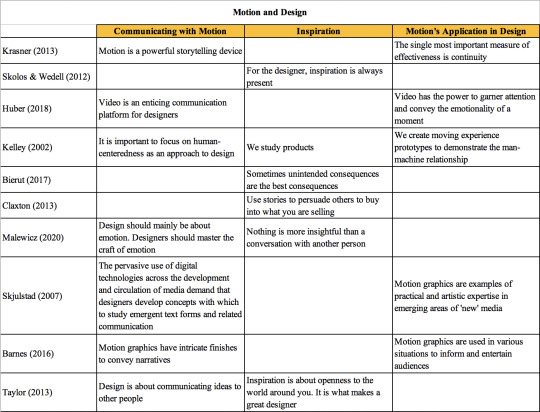
Annotated Bibliography
Barnes, S. (2016). Studies in the efficacy of motion graphics: The effects of complex animation on the exposition offered by motion graphics. Animation 11(2), 146-168. https://doi.org/10.1177/1746847716637823
This article from Animation examines motion graphics and how they are used in various venues for the purpose of informing and entertaining audiences. The article investigates how the intricate finishes and the sometimes-complex animations are used to present visual explanations of subject matter or to convey narratives. While the author conducts a quasi-experimental study exploring how viewers interact with expository graphics that provide visual explanations, the author presents very little research on motion graphics and the effects of animation on the viewing experience. This resource is for anyone who is interested in cognitive load theory in relation to the user viewing experience. This resource is not for people who want a more detailed look into communicating with motion. They should instead research or motion’s application in design or the rise of motion within the design communication framework.
Skjulstad, S. (2007). Communication design and motion graphics on the web. Journal of Media Practice 8(3), 359-378. http://dx.doi.org/10.1386/jmpr.8.3.359_1
This articles from the Journal of Media Practice examines the mediation of online portfolios of contemporary designers working with motion graphics. It addresses designers’ inclusion of motion graphics in web design. The article combines perspectives on static and dynamic communication designs and how such designs give users multiple modes and means of co-constructing meaning. While the author does offer an examination of the application of motion in web design, the article does not go into the activities of the users, nor does it offer a broad enough analysis of the use of motion design as a communication tool. While the author sees motion graphics as integral to websites and their communication design, this resource is for anyone who wants a survey of motion graphics and its use in web design. For anyone who wants to know about how motion graphics is used in other contexts, one should research topics such as motion’s application in design.
Taylor, A. (2013). Design essentials for the motion media artist. Focal Press.
This book from Focal Press discusses the concepts and principles of motion graphic design and how to apply them. It demonstrates how to manipulate and bend rules to create unique design solutions and achieve communication goals. This book is about digital media design – a new, evolving area that encompasses many disciplines. The author takes the reader on a journey to explore the fundamentals of design. The goal is to provide inspiration, motivation, and knowledge to designers who have a good handle on the technical side of things but would like a refresher course on some of the fundamentals of design; students of digital media and motion graphics courses; and their teachers. She also provides an industry perspective that is based on her 16-year career in the digital media industry. This resource is for anyone who wants a practical guide to the principles and techniques of motion media, and who uses computers to generate animation or video content for the web, television, film, or any other form of media.
** Include in the Annotated Bibliography the complete APA references for each source you found AND provided by the instructor (including live session material) **
References:
AIGA. (n.d.). Design for good. AIGA. https://www.aiga.org/design-for-good
AIGA. (n.d.). Designing for social change: Stumbles to strategies. AIGA. https://www.aiga.org/designing-for-social-change-stumbles-to-strategies
AIGA. (2014). Women Lead Initiative. AIGA. https://www.aiga.org/women-lead-initiative
Barnes, S. (2016). Studies in the efficacy of motion graphics: The effects of complex animation on the exposition offered by motion graphics. Animation 11(2), 146-168. https://doi.org/10.1177/1746847716637823
Beckett, S. (2017). The logic of the design problem: A dialectical approach. Design Issues, 33(4), 5-16.
Bierut, M. (2017). How to design a library that makes kids want to read [Video]. TED. https://www.ted.com/talks/michael_bierut_how_to_design_a_library_that_makes_kids_want_to_read#t-257693
Claxton, E. (2013, October 11). Stories and the art of Persuasion [Video]. AIGA. https://www.aiga.org/aiga/content/events-and-competitions/aiga-events/head-heart-hand-aiga-design-conference/video-eve-claxton/
Collins, B. (2018). 3 Strategies for developing innovative thinking. Forbes. https://www.forbes.com/sites/bryancollinseurope/2018/06/25/innovativethinking/#28a38d867b88
Gosselin, D., Cooper, S., Bonnstetter, R., & Bonnstetter, B. (2013). Exploring the assessment of twenty-first century professional competencies through a business-academic partnership. Journal of Environmental Studies and Sciences, 3, 359-368. https://doi.org/10.1007/s13412-013-0140-1
Huber, A. (2018). Telling the design story: Effective and engaging communication. Taylor & Francis
Kelley, D. (2002). Human-centered design [Video]. TED. https://www.ted.com/talks/david_kelley_human_centered_design/transcript#t-910709
Krasner, J. (2013). Motion graphic design: Applied history and aesthetics (3rd ed.). Focal Press.
Malewicz, D. (2020, May 4). The emotional design manifesto. UX Collective. https://uxdesign.cc/the-emotional-design-manifesto-7cfdbd2d55e9
Skolos, N., & Wedell, T. (2012). Graphic design process: From problem to solution 20 case studies. Laurence King.
Skjulstad, S. (2007). Communication design and motion graphics on the web. Journal of Media Practice 8(3), 359-378. http://dx.doi.org/10.1386/jmpr.8.3.359_1
Taylor, A. (2013). Design essentials for the motion media artist. Focal Press.
[trunklayla]. (2012, March 23). Tiny Story [Video]. YouTube. https://www.youtube.com/watch?v=oZgshtBZsSE
Outcomes and Knowledge
Motion in design was studied further this week. The idea that motion can be used to communicate more effectively than static media was examined more closely. Designers must always determine whether motion is the most appropriate approach to their design solutions, audience, content and context (Beckett, 2017, p. 12), but it must be considered, nonetheless. Motion gives designers yet another way to engage consumers and is quickly becoming an integral part of communication design. For the user, motion graphics creates another mode and means to co-construct meaning. This paper discusses and explores the material and concepts learned in the third week of the Organizational Structures course from the perspective of the degree learning outcomes – connecting, synthesizing, and transforming; problem solving; innovative thinking; and acquiring competencies.
Connecting, Synthesizing, Transforming
The research conducted this week was guided by a combination of information provided by the course instructor, web searches, reading through books and searching through the Full Sail research databases. The focus of the research was with regard to communicating with motion, and motion’s application in design. Sources were used that touched on these broad topics, but that also included the importance of motion in design, and inspiration. Connections were made between Skjulstad, Taylor, and Barnes. Skjulstad (2007) states, with regard to communicating with motion, that the pervasive use of digital technologies across the development and circulation of media demand that designers develop concepts with which to study that communication. Barnes (2016) posits that motion graphics uses intricate finishes and animations (characters) to convey narratives, and Taylor (2013) claims that motion design is about effectively communicating ideas to other people. Each of these authors share a similar viewpoint and as such, to apply this synthesis to the work in week three, motion was used to create more effective messages to the target audience. In the design challenge for example, to create an animated logo, the brand personality had to be considered so that the design choices – colors, movements, music, and type – and the message across the entire brand were fluid. The desired outcome was to animate a logo that would demonstrate community and inclusivity. The outcome was not as expected insofar as the design would have benefitted more from the different aspects of the icon coming together to show a literal coming together that the brand represents.
Here is the final animated logo:
youtube
References:
Barnes, S. (2016). Studies in the efficacy of motion graphics: The effects of complex animation on the exposition offered by motion graphics. Animation 11(2), 146-168. https://doi.org/10.1177/1746847716637823
Skjulstad, S. (2007). Communication design and motion graphics on the web. Journal of Media Practice 8(3), 359-378. http://dx.doi.org/10.1386/jmpr.8.3.359_1
Taylor, A. (2013). Design essentials for the motion media artist. Focal Press.
Solving Problems (Women Lead Initiative Case Study)
In design, a problem represents a fundamental object of concern (Beckett, 2017, p. 5), as opposed to hinderances that occur or wrenches that are thrown into one’s work. It is often posed as a question such as, how can one thing be done while some other thing is a factor? The problem identified in the Women Lead Initiative is how can women be empowered in design when leadership, representation, and parity remain a challenge (AIGA, 2014). Two possible paths to a solution identified by the case study were first to cultivate awareness of gender-related issues, while building knowledge and leadership skills, and second, to connect women and men and facilitate relationships within and beyond the design industry. Both paths work together, but ultimately, empowering women in design and advancing the vital discourse on issues facing professional women today without segregating women designers was the successful solution. This solution was successful because its goal was to bring men together with women to solve the gender-inequity issues in the design field. Men have responded to the feminist movement in very different ways. However, feminists too have at times taken a separatist stance, seeing the challenge of gender equality as resting exclusively with women. This is changing now as most gender-equity advocates recognize that solidarity and understanding intersectionality are essential to achieving equity objectives.
The Women Lead Initiative ad uses motion in the final design solution and it effectively added depth to the message (Scirocco 2014), making it fun and engaging.
Here is an image of the static design (the motion graphic can be viewed here):
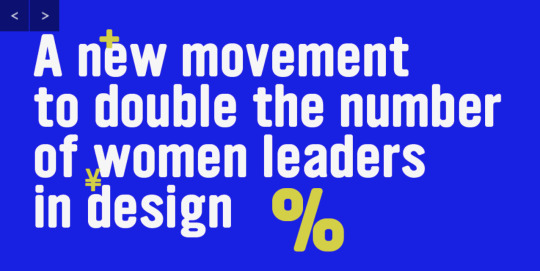
References:
AIGA. (2014). Women Lead Initiative. AIGA. https://www.aiga.org/women-lead-initiative
Beckett, S. (2017). The logic of the design problem: A dialectical approach. Design Issues, 33(4), 5-16.
Scirocco, A. (2014, February 21). The creative spark: Alberto Scirocco and the motion graphics of Leftchannel. Lynda. https://www.lynda.com/Video-Motion-Graphics-tutorials/Alberto-Scirocco-motion-graphics-leftchannel/153774/164032-4.html
Innovative Thinking (Women Lead Initiative Case Study)
Innovative thinking is thinking that goes beyond common practice or procedure, employing thinking outside of the box. It is disruptive in nature, but it is only with innovative thinking that some remarkable things can happen. The common practice with initiatives such as this one, where there are gender-disparity issues, is to draw attention to the issue and to create a code of conduct which ultimately alienates the group that already feels alienated, with the hope that it will improve the gender balance in senior design roles, for example. However, “people tend to ignore what doesn’t directly affect them,” (AIGA, 2014). To draw people in, the AIGA Women Lead initiative made connections between different ideas which did not seem connected (Collins, 2018) and came up with a series of programs, events, and resources for an inclusive audience – women and men, emerging designers and seasoned professionals, members and nonmembers. Using empathy here made the difference (Kelley, 2002).
Here is an example of a code of conduct which is common practice in gender-equality initiatives:

Here is a list of some of the resources created by the Women Lead Initiative:

References:
AIGA. (2014). Women Lead Initiative. AIGA. https://www.aiga.org/women-lead-initiative
Collins, B. (2018). 3 Strategies for developing innovative thinking. Forbes. https://www.forbes.com/sites/bryancollinseurope/2018/06/25/innovativethinking/#28a38d867b88
Kelley, D. (2002). Human-centered design [Video]. TED. https://www.ted.com/talks/david_kelley_human_centered_design/transcript#t-910709
Acquiring Competencies (Research and Design Challenge)
Acquiring competencies is at the foundation of individual and collective success in the workplace (Gosselin et al., 2013). This week helped further my understanding of the value of communicating with motion, the importance of motion in design, and motion’s application in design. Motion design informs users by highlighting relationships between elements, it focuses attention on what is important without creating unnecessary distraction, and it adds character to common interactions, and can help express a brand’s language (“Understanding motion,” n.d.). I was able to practice more in Adobe After Effects by animating two logos, one by following a tutorial in LinkedIn Learning, and another from a logo I created in one of my earlier classes in the Media Design MFA program. This week further demonstrated that studying the world with an empathetic lens is an important aspect of design research and problem-solving.
I was able to identify at least three concepts that were relevant to the course this week:
Selective attention (occupational, conceptual) – This is the process of directing our awareness to what is relevant while simultaneously ignoring what is irrelevant in the environment (Simons, 2010).
Hierarchies in motion (occupational, conceptual) - The human visual system analyses moving objects to arrange them in order of importance (Gershman et al., 2016). Motion helps orient users by showing how elements are related.
Human-centered design (occupational, conceptual) - This is an approach to problem-solving that considers the human perspective through the entire process by using empathy which helps the designer make sense of what consumers are saying or hinting at (Dam & Teo, 2019).
All three of these concepts are certainly important in the academic field, they are all labeled as occupational because they pertain more to conducting business in the media design field. They are further categorized as conceptual because they do not pertain to particular software or technical skill, but to ideas that can be interpreted differently by different people.
References:
Dam, R. F. & Teo, Y. S. (2019, April 6). Design thinking: Getting started with empathy. Interaction Design Foundation. https://www.interaction-design.org/literature/article/design-thinking-getting-started-with-empathy
Gershman, S., Tenenbaum, J. & Jäkel, F. (2016). Discovering hierarchical motion structure. Vision Research, 126, 232-241. https://doi.org/10.1016/j.visres.2015.03.004
Gosselin, D., Cooper, S., Bonnstetter, R., & Bonnstetter, B. (2013). Exploring the assessment of twenty-first century professional competencies through a business-academic partnership. Journal of Environmental Studies and Sciences, 3, 359-368. https://doi.org/10.1007/s13412-013-0140-1
Material. (n.d.). Understanding motion. Material. https://material.io/design/motion/understanding-motion.html
Simons, D. (2010, March 10). Selective attention test [Video]. YouTube. https://www.youtube.com/watch?v=vJG698U2Mvo
Reflection
One of the concepts discussed this week was selective attention. We are constantly bombarded by an endless array of internal and external stimuli, thoughts, and emotions. To varying degrees of efficiency, we have developed the ability to focus on what is important while blocking out the rest. Selective attention is the process of directing our awareness to what is relevant while simultaneously ignoring what is irrelevant in the environment (Simons, 2010). Because there are myriad stimuli competing for people’s attention, the designer has to create messaging that is strong enough to pierce through all of the noise. Another of this week’s concepts is with regard to hierarchies in motion. The theory of hierarchical motion perception states that the human visual system analyses moving objects to arrange them in order of importance (Gershman et al., 2016). Motion helps orient users by showing how elements are related. A successful format is one that guides the viewer through the elements to a specific message. Finally, human-centered design or design empathy was one of the concepts discussed this week. This approach to problem-solving considers the human perspective through the entire process by using empathy. Empathy helps the designer make sense of what is being said, or what is hinted at (Dam & Teo, 2019). By observing people designers can identify and then offer solutions for their unexpressed and unmet needs.
Motion is a powerful cue for understanding the organization of a visual scene. Learning how to use motion in my designs will definitely give me an edge in the design industry. This week, I was able to further my study of Adobe After Effects by animating two logos. My goal is to really push myself to master this program because I can really see the benefit of motion in connecting with an audience and adding depth to a message. It is also neat to see the finished product when I create something. Prior to this week’s design challenge, I did not know how to animate a logo – I learned how to import a logo from Adobe Illustrator and separate the layers to animate each one individually. This helped me to better create the message that I wanted to reach my target audience. I learned the basics of determining how my logo should be animated to grab my audience’s attention. I first took a look at the brand’s personality and chose the aspects of inclusivity and community to create the animation around. It was important not to use colors or music that did not communicate the brand’s personality. Finally, I had to consider how I wanted to reveal each part of the logo – the icon and the logotype. My final design did not turn out exactly how I wanted it to, but I am going to practice more to have each of the hexagons come together. The entire process was challenging but rewarding. It was a fun experience, and Adobe After Effects is definitely one of the applications I want to know and keep in my design toolkit.
References:
Gershman, S., Tenenbaum, J. & Jäkel, F. (2016). Discovering hierarchical motion structure. Vision Research, 126, 232-241. https://doi.org/10.1016/j.visres.2015.03.004
Simons, D. (2010, March 10). Selective attention test [Video]. YouTube. https://www.youtube.com/watch?v=vJG698U2Mvo
Dam, R. F. & Teo, Y. S. (2019, April 6). Design thinking: Getting started with empathy. Interaction Design Foundation. https://www.interaction-design.org/literature/article/design-thinking-getting-started-with-empathy
0 notes
Photo

NOTE: The following contains some spoilers.
Justice League (2017)
Under the leadership of Zack Snyder, the DC Extended Universe (DCEU) has begun with embarrassing efforts including Man of Steel (2013), Batman v Superman: Dawn of Justice (2016), and Suicide Squad (2016). The outlook at Warner Bros. was grim, facing diminishing box office returns and vicious critical reviews. This summer, it took Wonder Woman to provide any hope that the DCEU was on an upward trajectory. In comes Justice League, a film that marks a step forward for Warner Bros.’ most important franchise, but is troubled by writing its way out of the holes dug by Snyder in Man of Steel and especially Batman v Superman. With Zack Snyder’s Justice League (alongside expensive reshoots by Joss Whedon, credited as co-writer with Chris Terrio), the DCEU remains in critical condition. But unlike the recent philosophical shallowness of the Marvel Cinematic Universe’s (MCU) militancy, the DCEU – in Wonder Woman and Justice League – is making an honest attempt at a superheroing dialectic.
Shortly after Superman’s death in Batman v Superman, Steppenwolf (Ciarán Hinds; the character is an alien general from Apokolips who serves Darkseid) has landed on Earth to retrieve three Mother Boxes and harness the boxes’ aggregate powers to commence Earth’s destruction. No one knows the exact capabilities, purposes, or origins of the Mother Boxes, but Amazonian Queen Hippolyta (Connie Nielsen) warns Diana Prince (Gal Gadot; Wonder Woman) of Steppenwolf’s arrival. Diana joins forces with Bruce Wayne (Ben Affleck; Batman) and, together, recruit Arthur Curry (Jason Momoa; Aquaman), Barry Allen (Ezra Miller; The Flash), and Victor Stone (Ray Fisher; Cyborg). Steppenwolf and his army of Parademons are making quick work of finding the boxes, and – this should come as no surprise to anyone paying attention to the DCEU – our superheroes exhume and reanimate Clark Kent (Henry Cavill; Superman) in preparation for the final showdown.
The supporting cast is unwieldy – as in any superhero team movies – but the prominent members include: Bruce’s butler Alfred Pennyworth (Jeremy Irons); Clark’s mother, Martha Kent (Diane Lane); Clark’s love interest but, most importantly, Pulitzer-Prize winning journalist for the Daily Planet Lois Lane (Amy Adams); and Gotham City Police Commissioner James Gordon (J.K. Simmons).
Before delving into the heart of this write-up, note that Zack Snyder departed the project after a sudden family emergency. Joss Whedon (who directed the first two Avengers movies) replaced Snyder, re-wrote scenes, and filmed reshoots. The stylistic differences between the two directors clash throughout Justice League – Snyder has always relied on a desaturated brown- and black-heavy color palette, foreboding self-importance, and an attitude toward life that is a cross between an emotionally bankrupt nihilist and that edgy fellow from your Intro to Philosophy class trying to be “deep”, but failing; Whedon established the MCU’s quip-heavy dialogue in favor of slowing down the action and showing us where a superhero’s humanity comes from, oftentimes interrupting thoughtful moments and conversations like a loud frat boy with a tenuous command of the subject being talked about (the frat boy might actually be “deep”, but he has trouble expressing himself).
I profess to appreciate Whedon’s writing only a little more than Snyder’s. Self-important superhero movies need to earn their somberness – see Christopher Nolan’s Dark Knight trilogy – and humanizing those with superpowers is something that post-Spider-Man 2 (2004) superhero movies have all but forgotten to do. So the Whedon-esque comedic dialogue is appreciated, if occasionally misplaced in the thick of a violent scene. In other times, Whedon’s dialogue is entirely inappropriate and will unintentionally have the audience burst out in disbelieving guffaws. Let us take the scene where Superman returns with Lois Lane to Smallville.
Lois’ first line is to tell Clark that he smells good.
“Didn’t I smell good before?” he asks.
That is the first thing she says in their first private moment together? And second, wouldn’t being buried six feet under make you smell like earthworms? I guess Kryptonian pheromones are pretty resilient even in death! Soon after, Lois asks Clark what was it like being dead.
“Itchy,” he says.
Itchy? Is the Kryptonian afterlife filled with Kryptonian fleas (bad news for Krypto the Superdog if that’s the case)? To pull back before I pick and choose dozens of individual lines of dialogue for ridicule, Whedon’s comedic tendencies – not for the first time – destroy any sense of intimacy between friends, lovers, and family. A Whedon-written subplot about a Russian family fleeing the final battle sequence is manufactured and manipulative, rather than horrifying or inspiring.
For Snyder (and Terrio, who worked with both Snyder and Whedon and whose contributions are less clear), his writing belies little interest in adding dimensions to Steppenwolf. The worst of Snyder appears immediately after Superman is resurrected as Batman, Wonder Woman, Cyborg, and The Flash must combat the awoken Man of Steel in a battle that does not serve anybody’s characterization or the plot’s progression. It is a superficial battle fulfilling Snyder’s dependency on unnecessary violence to keep interest going.
Yet Snyder is also responsible for the film’s most inspiring moment. Unfortunately, that comes in the opening minutes as the film introduces Wonder Woman. She is seen defending civilians from terrorists threatening to obliterate a London bank. From the sequential progression of the moment – despite being deprived of too much context – and the impressive visual effects, it builds off Patty Jenkins and Allan Heinberg’s characterization of Wonder Woman earlier this year. And though the final line of that introductory scene smacks of cheesiness (”Who are you?”; “A believer.” Is Diana a Monkees fan?), it retains what was essential of Jenkins’ interpretation of Wonder Woman: that Diana has always been motivated not by personal animus, but a genuine, learned belief in humanity’s characteristic and fragile goodness. It is a brief moment, this. Yet in that snippet, Zack Snyder – whether he internalized these lessons or not – provides a moment worthy of cheers and, yes, tears.
The balance of screentime between all six founding members of the DCEU’s Justice League (spare a thought for fans of omitted, original founding members Green Lantern and Martian Manhunter) is equal enough, although Aquaman does not truly factor until the final third of the film. For Aquaman, The Flash, and Cyborg, Justice League might feel like an extended trailer for their more interesting standalone movies. Regarding the film’s treatment of Wonder Woman, there are mixed results after that spectacular introduction. One-liners and comments about Wonder Woman’s attractiveness (Flash, Aquaman, and Alfred in particular) are unwelcome, undermining the professionalism seen in the Cartoon Network animated series Justice League / Justice League Unlimited (2001-2006) and even Hanna Barbera’s long-running Super Friends (1973-1986). The angles in which Wonder Woman is shot also contribute to feminists’ justified anger in how Snyder (who has never been concerned with feminism) and Whedon (a self-professed feminist, but whose behavior and past writing suggest otherwise) have portrayed her. Eventually, the film’s roughshod editing between the Snyder and Whedon versions provides a portrait of the Justice League to that is cluttered, confusing, contradictory.
In such a sizable ensemble picture so devoted to narrative and action, it seems useless to comment on performances. With the exception of Cavill and Affleck, every other lead and important supporting cast are doing a serviceable job (for Fisher, Miller, and Momoa, their shining moments will come in their respective movies). Cavill has the muscles, but his charm remains missing despite a more saturated suit for Superman – Cavill remains a more convincing antagonist than a protagonist. Affleck looks and sounds bored. He adds nothing to Bruce Wayne or Batman. Today, it seems even more impossible in film to make the Caped Crusader a sympathetic character – like the one found in the comics and animated television.
It is sympathy that brings us to the direction of this franchise. This paragraph should be read with the understanding that I do not read comic books and that I do not have the emotional ties that many others have to these characters. If Zack Snyder remains sidelined at the DCEU in future installments (unlikely at this juncture, as Warner Bros. did not sack him after multiple critical failures), the franchise’s primary problem will no longer be that it peddles in malformed ideas and soul-heaving darkness. In this case, the primary problem of the DCEU is making its characters sympathetic – allowing the audience to understand each hero’s sense of altruism and showing us where that comes from (e.g. family-instilled values, personal losses processed or otherwise, childhood loneliness into compassion) and having the Justice League become something inspirational to those unable to defend themselves.
Making characters sympathetic sounds simple (anything but!), but it is a good primary problem to have considering the recent history of superhero films. The DCEU has no problems making its superheroes feel larger-than-life. There are few character visibility or recognizability obstacles. As long as the DCEU avoids stunts like Superman’s “death” and Man of Steel’s heinous thesis that the only way for Superman to truly cherish life is to kill someone, its regard for life and understanding of death’s gravity is intact. These are foundational aspects of superhero narratives that must be recognized. Regarding sympathetic superheroes, the DCEU has Wonder Woman (the MCU wasted Captain America due to a convoluted conspiracy-thriller maze of an overarching plot and an unwillingness or inability to meditate on mature themes; the DCEU may yet squander Gal Gadot’s Diana) and must endeavor to make its future installments just as appealing. The MCU might be making the better movies, but this is where the DCEU can still mount its challenge.
Again, realize that almost all of the above is dependent on Zack Snyder’s permanent departure from DCEU films and a need for better writers.
Justice League’s music score has become one of the fiercest points of contention among hardened fans. Just as the DCEU has become the most visible battleground for the soul of superhero movies, it is also the frontline for the future of film scoring. In June 2017, Junkie XL (2015′s Mad Max: Fury Road, Batman v Superman) was replaced with Danny Elfman (1989′s Batman, 1990′s Edward Scissorhands). Junkie XL, who has collaborated multiple times with Zimmer, is a DJ and audio engineer first, a composer second (sorry, but all those categories are distinct), and is interested in rhythm and ambience. Elfman, who has composed for superhero media for almost thirty years, is classically influenced with a rock and ska background, and has always been regarded for his melodic and harmonic constructions. American movies – whether independents or major studio tentpoles – have been moving away from traditional orchestra-based film scoring in recent years in favor of electronic music and Zimmer’s drum “choruses”. Controversy among DC fans ensued when Elfman announced he would recall his theme to 1989′s Batman and John Williams’ Superman theme rather than continue some of Zimmer’s previous musical ideas – the number of incendiary personal attacks directed against Elfman have been sickening and reflective of a lack of understanding of film music conventions and history.
I personally have mixed feelings about the Elfman score. While I despise Zimmer and his associates/ghostwriters’ DCEU contributions and refuse to believe their music is “revolutionary” in the ways they boast, Elfman’s decision to undermine the musical continuity of the DCEU resembles the compositional debacles with the MCU. The 1989 Batman theme is an imperfect, but adequate fit for Affleck’s Batman (variations can be heard early in “Batman on the Roof”; Elfman restrains himself until “Then There Were Three”); Cavill’s sleep-inducing Superman does not yet deserve the soaring strings and inspiring brass and woodwinds that fit Christopher Reeve’s portrayal of the Man of Steel (Williams’ theme is buried underneath a thunderous sound mix, but its renditions in minor key suggests Elfman considered Cavill’s Superman and applied the theme in a suitable fashion). In ways that Hans Zimmer and Junkie XL could never provide, Wonder Woman’s theme is, for the first time, not played by electric cello, but by lower strings, brass, and guitar in “Wonder Woman Rescue”– diversifying the instrumentation is almost always rewarding, as evidenced here. Less developed are Elfman’s hints to themes for Aquaman, Cyborg, and The Flash for any future composers to build upon if they so desire.
For all my gripes about the score and lack of new, recognizable motifs (Elfman’s score is motif-heavy), film composers rooted in classical music have an advantage over composers using drum choruses and harsh electronics: orchestras are more capable to carry multiple, harmonically independent themes in a single cue and have those themes in dialogue with each other. And though it is played underneath the combat, “The Final Battle” is a gorgeous orchestral action cue combining motifs that – and it feels so strange to write this – help tell the story of the battle.
Adjusted for inflation, Justice League is the third-most expensive film ever made – behind the 2011 and 2007 Pirates of the Caribbean movies and ahead of Titanic (1997). With extensive reshoots and a committed effort by Warner Bros. for an extremely late, movie-saving operation, Whedon’s interventions improve the film, even if Justice League is a Frankenstein’s monster of a movie in all of its tonal inconsistency. As expectations beforehand remained abysmal, this Justice League is the best possible movie that could have been made with the talent attached to it. With the exception of perhaps Star Wars, the production history of the DCEU is just as dramatic as the events on-screen. Justice League shows that the producers, directors, and writers of the DCEU are actively learning from their prior mistakes.
The challenge is now to make these comic book superheroes into the ideal that their creators, decades ago, imagined for themselves, their readers, those who can still differentiate between justice and mercy.
My rating: 6/10
^ Based on my personal imdb rating. My interpretation of that ratings system can be found here.
#Justice League#DCEU#Zack Snyder#Ben Affleck#Gal Gadot#Joss Whedon#Henry Cavill#Ezra Miller#Jason Momoa#Amy Adams#Jeremy Irons#Diane Lane#Connie Nielsen#J.K. Simmons#Ciaran Hinds#Chris Terrio#Danny Elfman#Patrick Tatopoulos#My Movie Odyssey
5 notes
·
View notes
Text
Jack stalker Research Paper
“Wilted” – This title developed though out my pilot project as I was first looking into the direct juxtapositions of the natural and manmade, with the working title of “Naturals and Synthetics” to begin with. As the project progressed it became clear that the focus should not be on direct visual comparison but a review of the relationship between man and natural, with a visual take on man’s effect on nature. Therefore, the short yet powerful title “Wilted”, works so well as it describes the process of wilting which is the effect of the strain onto the life of nature. A common occurrence within the narrative of man and nature.
When researching this project, I visited galleries, looked at books and researched online focusing on journals and articles. For me the first step was to go to the library and take out several books on camera-less photography as this was my starting point. The most helpful book as titled “Shadow catchers” and focuses on camera-less photography from the V&A’s collections. From this book I found Pierre Cordier and Susan Derges, with an instant attraction to both their works which take a very different approach it was hard to decide where to start. It was clear the Pierre Cordier’s methods of applying oil to photographic paper in order to change the way the developer would react with the paper, provided clear and striking effects however for me to start this was too abstract. However, moving forward, I chose a focus on Susan Derges and chose to make shadow prints of fauna and flora in the sun, with the cyanotype method, as blue tones were very successful in her work. Having success from this I went to the V&A museum to see the Anna Atkins cyanotype prints that they had on display, then deciding that I should instead move my prints into the darkroom to use a controlled UV exposure unit to give crisper details of the plant structure much like Atkins prints.
With the development of this project, came the development of my research methods as I moved from looking at images and books to conceptual research. This came from looking into the man-made object as a theme, from this I found interest in readymade art once again. However, this time with a focus for the pairing of objects and how the artists like Man Ray paired items so that rather than the surroundings of an art gallery making them practically unusable or obsolete. Each object would break the other in a practical sense. Much like the hammer in a bottle titled ‘handle in a sleeve” by Man Ray or a wheel on a stool my Marcel Duchamp. Moving past simple pairings, I felt it necessary to research the actual relationship of man and nature from a conceptual view, looking at Heidegger’s “The question concerning technology” as well as “Being and time”. Where the ideas of “being” and what it means to “Sense” something important when reviewing the relationship between man and nature as it’s a fundamental question if nature can “Sense” or perceive its own being.
From my pilot project, I first had to learn about the fundamentals of camera-less photography, and how to make clear cyanotypes in the sun from 3D plants as opposed to the 2D digital negative which is what I was used to using. This was a very practical methodology, where I had to learn the timings on which to make the exposures as well as predict how the movement in the sun would affect the final exposure. Following this I took inspiration from Pierre Cordier and experimented with effecting the undeveloped paper with water, which would cause the chemicals to partly develop and then fix as it dried. Deciding to move on from the cyanotype process, I then took a focus to the studio however still wanted to keep successful aspects from my previous prints. An attraction to the cyanotypes was there minimal tones of blue and white, however still preserving a good amount of detail. This is what drove me to lowkey lighting in the studio, a method that carefully lights the images so that they are not underexposed but just showing darker tones. This took lots of refinement with several attempts at changing the lighting and experimenting with backlighting as well, to bring the structural details of the plant through to the surface.
These all practical developments to my methodology, with the most important developments to my concepts. Starting this project, I had no set direction or no set concept to abide by, which allowed me to just experiment and progress forward with successes. In doing so, however unclear to me at first, I was also developing a strong concept behind the works. This being my lust to manipulate the natural details of the plant within the image, which then came to be reflecting on the way man manipulates the natural, and just exploring this relationship and narrative. This is the core concept that will be the primary focus for my major project, moving forward.
When reflecting on the context for the images which I am producing it is clear to me how they should be presented. This being printed life-size and shown on the wall. This is so that the images preserve as much of the subtle details as possible when printed, choosing a semi-gloss paper so that the blacks are pronounced with a deep tonal range, however, the paper does not shine too much so that it distracts from the image. The reasoning for a life-size print is that visually it allows the viewer to gain an overall perception of the image yet if wanted they are invited to come closer to explore the intricacies within the dark tones. Interestingly the project started with a much more physical image which was the small cyanotypes, which worked very well on the page of a book or in a small frame on the wall. An important link between this is that both types of prints were Life-size so it can be said is a successful theme to the pilot project which stayed thought the whole development process.
When looking at the histories behind my final images they have a likeness to that of Dutch still-life paintings of flowers, which in many ways were an inspiration to my work as they focus on constructed scenes with subtle details to draw in the viewer. This making it only natural for my work to suit the wall space so that it has a negative room around the print not to cause distractions as the print does not forcefully grab attention but rather rely on a natural curiosity from the viewer.
When talking about the production methods behind my images, drastic changes have been made throughout regarding process however the fundamental subject and subject presentation has remained. The primary development to subject presentation in the image is that in the cyanotypes the focus was on loss of a third dimension to the subject in order to keep the image simple and minimal not to detract from the subject. Yet in the low-key photographs the image remains minimal through the tonal range yet still has large depth the physicality of the subject. An important idea as the relationship between man and nature is a very physical one.
References
Aesthetica Magazine. (2020). Aesthetica Magazine - Is the Readymade Still Revolutionary?. [online] Available at: https://www.aestheticamagazine.com/is-the-readymade-still-revolutionary/ [Accessed 9 Jan. 2020].
Atkins, A. (1880). Photographs of British algae.
Atkins, A., Schaaf, L. and Kraus, H. (1985). Sun gardens. New York, N.Y.: Aperture.
Barnes, M. (2010). Shaddow Catchers Camera-less Photography. 1st ed. London: V&A.
Barnes, M. (n.d.). Cameraless photography. London: V&A.
Child, J. (2005). Studio photography. Amsterdam: Elsevier/Focal Press.
Heidegger, M. and Lovitt, W. (n.d.). The question concerning technology, and other essays.
Translating Heidegger's Sein und zeit. (2005). Bucharest: Humanitas.
0 notes
Text
Real:Time:Love 3 Episode 8 [ENGSUB] Korean Drama Series 2020
Watch Real:Time:Love Season 1 Episode 8 1–2–3–4–5–1–7–8–9–10 Full Episode
Real:Time:Love Temporada 1 Capítulo 8 Sub English / Español 2020 ➤ http://watchepisode.online-tvs.com/series/380261/3/8
VISIT HERE ➤➤ http://watchepisode.online-tvs.com/series/380261/3/8

Real Time Love is a sitcom-like web drama that follows the honest, curious stories of 18-year-olds. (Can be watched in 킼TV (WHY NOT) channel both on YouTube and V LIVE).
🎬 Real:Time:Love 3 Episode 8 Online Free 🎬
Title : Real:Time:Love
Episode Title : Episode 8
Release Date : 02 Oct 2020
Runtime : 15 minutes
Genres : Comedy , Drama , Mini-Series , Romance
Networks : VLIVE
Real:Time:Love 3
Real Time Love sitcom-like web drama that follows the honest, curious stories of 18-year-olds.
Show Info
Web channel: Korea, Republic of Naver TVCast (2019 - now)
Schedule: Fridays at 20:00 (15 min)
Status: Running
Language: Korean
Show Type: Scripted
Genres: Drama Comedy Romance
Episodes ordered: 8 episodes
With dozens of films genre being released each year, a typical one that gets overlooked by the more popular ones (action, drama, comedy, animation, etc.) is the subgenre category of religious movie. These films (sometimes called “faith-based” features) usually center around the struggles and ideas of a person (or groups) identity of a religious faith, which is, more or less, has a profound event or obstacle to overcome. While not entirely, the most commonplace religious type movies focus on the religion of Christianity, sometimes venturing back into the past in cinematic retelling classic biblical tales, including famed epic films like Ten Commandments and Ben-Hur (the original 1959 version) to some more modern endeavors from Hollywood like Risen, The Young Messiah, and Paul, Apostle of Christ. Other Christian “faith” films finds a more contemporary setting to tell its story, with some being “based on a true-life account” like the movies Unconditional, Heaven is Real, Unbroken, I Can Only Imagine, Indivisible, and Miracles from Heaven, while others might find inspiration from literary novels / fictionalized narratives like The Shack, Overcomer, War Room, and Same Kind of Different as Me. Regardless, whether finding inspiration from true life, references from the bible, or originality, these movies usually speaks on a person’s faith and the inner struggle he or she has within or one society’s views, spreading a message of belief and the understand of one’s belief. Now, after the success of 2018’s I Can Only Imagine, directors Andrew and Jon Erwin (the Erwin Brothers) and Lionsgate studios release the 2020 faith-based film / music biopic feature I Still Believe. Does the film walk a fine line between its religious aspects and cinematic entertainment or does the movie get entangled in its own faith-based preaching?
THE STORY
Its 1999 and Jeremy Camp (K.J. Apa) is a young and aspiring musician who would like nothing more than to honor his God through the power of music. Leaving his Indiana home for the warmer climate of California and a college education, Jeremy soon comes across one Melissa Henning (Britt Robertson), a fellow college student that he takes notices in the audience at a local concert. Falling for cupid’s arrow immediately, he introduces himself to her and quickly discovers that she is attracted to him too. However, Melissa holds back from forming a budding relationship as she fears it will create an awkward situation between Jeremy and their mutual friend, Jean-Luc (Nathan Parson), a fellow musician and who also has feeling for Melissa. Still, Jeremy is relentless in his pursuit of her until they eventually find themselves in a loving dating relationship. However, their youthful courtship with each other comes to a halt when life-threating news of Melissa having cancer takes center stage. The diagnosis does nothing to deter Jeremey’s love for her and the couple eventually marries shortly thereafter. Howsoever, they soon find themselves walking a fine line between a life together and suffering by her illness; with Jeremy questioning his faith in music, himself, and with God himself.
THE GOOD / THE BAD
Sorry if this sounds a bit familiar pieces from my review of I Can Only Imagine, but it definitely says what I feel about these films. While I am a devout Christian (not a crazy zealot or anything like that) for my bases of religion and my outlook beliefs in life, I’m not a huge fan of the “faith-based” feature films. That’s not to say that they’re bad or that I find them deplorable to the other more popular movie genres out there, but sometimes they can a bit preachy and corny / honky in their religious overtones and overall dramatic direction. Personally, I like the more biblical tales that Hollywood as put over, with Cecil B. Demile’s The Ten Commandments and William Wyler’s Ben-Hur; both of have proven to stand the test of time within filmmaking. Of course, Hollywood’s recent trend of put out more “remakes” movies puts an overcast on those biblical epics with 2014’s Exodus: Gods and Kings and 2016’s Ben-Hur; both of which failed to capture a sense of cinematic integrity and had a messy religious outlook in its zeal aspect. Of late, however, Hollywood as retreated more into contemporary pieces, finding narratives that are, more or less, set in a more “modern” day and age to their Christian-faithful based features. As I mentioned above, some have found success in their literary forms (being based on a book and adapted to the big screen), but most derive their inspiration from true life accounts, translating into something that’s meant to strike a chord (with moviegoers) due to its “based on a true story” aspect and nuances. Again, some are good (as I liked Unbroken and The Shack), while others kind of become a bit too preachy and let the religious overtures hamper the film, making them less-than desirable to mainstream audiences or even members of their own faiths. Thus, these religious-esque films can sometimes be problematic in their final presentation for both its viewers and in the film itself; sometimes making the movie feel like a TV channel movie rather than a theatrical feature film.
This brings me around to talking about I Still Believe, a 2020 motion picture release of the Christian religious faith-based genre. As almost customary, Hollywood usually puts out two (maybe three) films of this variety movies within their yearly theatrical release lineup, with the releases usually being around spring time and / or fall respectfully. I didn’t hear much when this movie was first announced (probably got buried underneath all the popular movies news on the newsfeed). My first actual glimpse of the movie was when the film’s movie trailer was released, which looked somewhat interesting to me. Yes, it looked the movie was gonna be the typical “faith-based” vibe, but it was going to be directed by the Erwin Brothers, who directed I Can Only Imagine (a film that I did like). Plus, the trailer for I Still Believe premiered for quite some time, so I kept on seeing it a lot of time when I went to my local movie theater. You can kind of say that it was a bit “engrained in my brain”. Thus, I was a bit keen on seeing it. Fortunately, I was able to see it before the COVID-19 outbreak closed the movie theaters down (saw it during its opening night), but, due to work scheduling, I haven’t had the time to do my review for it…. until now. And what did I think of it? Well, it was pretty “meh”. While its heart is definitely in the right place and quite sincere, I Still Believe is a bit too preachy and unbalanced within its narrative execution and character developments. The religious message is clearly there, but takes too many detours and not focusing on certain aspects that weigh the feature’s presentation.
As mentioned, I Still Believe is directed by the Erwin Brothers (Andrew and Jon), whose previous directorial works include such films like Moms’ Night Out, Woodlawn, and I Can Only Imagine. Given their affinity attraction religious based Christian movies, the Erwin Brothers seem like a suitable choice in bringing Jeremy Camp’s story to a cinematic representation; approaching the material with a certain type of gentleness and sincerity to the proceedings. Much like I Can Only Imagine, the Erwin Brothers shape the feature around the life of a popular Christian singer; presenting his humble beginnings and all the trials and tribulations that he must face along the way, while musical songs / performance taking importance into account of the film’s narrative story progression. That’s not to say that the movie isn’t without its heavier moments, with the Erwin, who (again) are familiar with religious overtones themes in their endeavors, frame I Still Believe compelling messages of love, loss, and redemption, which (as always) are quite fundamental to watch and experience through tragedy. This even speaks to the film’s script, which was penned by Erwin brothers playing double duty on the project, that has plenty of heartfelt dramatic moments that will certainly tug on the heartstrings of some viewers out there as well as provide to be quite an engaging tale of going through tragedy and hardship and finding a redemption arc to get out of it. This is especially made abundantly clear when dealing with a fatal illness that’s similar to what Melissa undergoes in the film, which is quite universal and reflective in everyone’s world, with the Erwin Brothers painting the painful journey that Melissa takes along with Jeremy by her side, who must learn to cope with pain of a loved one. There is a “double edge” sword to the film’s script, but I’ll mention that below. Suffice to say, the movie settles quickly into the familiar pattern of a religious faith-based feature that, while not exactly polished or original, can be quite the “comfort food” to some; projecting a wholesome message of faith, hope, and love. Personally, I didn’t know of Jeremy Camp and the story of he and Melissa Henning, so it was quite a poignant journey that was invested unfolding throughout the film’s proceedings. As a side-note, the movie is a bit a “tear jerker”, so for those who prone to crying during these dramatic heartfelt movies….get your tissues out.
In terms of presentation, I Still Believe meets the industry standard of a religious faith-based motion pictures. Of course, theatrical endeavors like these don’t really have big budged production money to invest in the film’s creation. Thus, filmmakers have to spend their money wisely in bringing their cinematic tales to life on the silver screen. To that effect, the Erwin Brothers smartly utilized this knowledge in the movie’s creation; budgeting the various aspects of the background and genetic theatrical make-up that feel appropriate and genuine in the film’s narrative. So, all the various “behind the scenes” team / areas that I usually mention (i.e. production designs, set decorations, costumes, and cinematography, etc.) are all relatively good as I really don’t have much to complain (whether good or bad) about them. Again, they meet the industry standard for a faith-based movie. Additionally, the musical song parts are pretty good as well. As mentioned, I really didn’t know anything about Jeremy Camp, so I couldn’t say what songs of his were good, but the songs that are presented in the film were pretty decent enough to certain highlight points throughout the movie. Though they are somewhat short (assuming not the whole song is being played), but still effectively good and nice to listen to. Might have to check out a few of the real songs one day. Lastly, the film’s score, which was done by John Debney, fits perfect with this movie; projecting the right amount of heartfelt tenderness in some scenes and inspirational melodies of enlightenment in others.
Unfortunately, not all is found to be pure and religiously cinematic in the movie as I Still Believe gets weighed down with several major points of criticism and execution in the feature. How so? For starters, the movie feels a bit incomplete in Jeremy Camp’s journey. What’s presented works (somewhat), but it doesn’t hold up, especially because the Erwin Brothers have a difficult time in nailing down the right narrative path for the film to take. Of course, the thread of Jeremy and Melissa are the main central focus (and justly so), but pretty much everything else gets completely pushed aside, including Jeremy’s musical career rise to stardom and many of the various characters and their importance (more on that below). This also causes the film to have a certain pacing issues throughout the movie, with I Still Believe runtime of 116 minutes (one hour and fifty-six minutes) feeling longer than it should be, especially with how much narrative that the Erwin Brothers skip out on (i.e. several plot chunks / fragments are left unanswered or missing).
Additionally, even if a viewer doesn’t know of Jeremy Camp’s story, I Still Believe does, for better or worse, follow a fairly predictable path that’s quite customary for faith-based movie. Without even reading anything about the real lives of Jeremy and Melissa prior to seeing the feature, it’s quite clearly as to where the story is heading and what will ultimately play out (i.e. plot beats and theatrical narrative act progression). Basically, if you’ve seeing one or two Christian faith-based film, you’ll know what to expect from I Still Believe. Thus, the Erwin Brothers don’t really try to creatively do something different with the film…. instead they reinforce the idealisms of Christian and of faith in a formulaic narrative way that becomes quite conventional and almost a bit lazy. There is also the movie’s dialogue and script handling, which does become problematic in the movie’s execution, which is hampered by some wooden / forced dialogue at certain scenes (becoming very preachy and cheesy at times) as well as the feeling of the movie’s story being rather incomplete. There’s a stopping point where the Erwin Brothers settle on, but I felt that there could’ve more added, including more expansion on his music career and several other characters. Then there is the notion of the film being quite secular in its appeal, which is quite understandable, but relies too heavy on its religious thematic messages that can be a bit “off-putting” for some. It didn’t bother me as much, but after seeing several other faith-based movies prior to this (i.e. I Can Only Imagine, Overcomer, Indivisible, etc.), this particular movie doesn’t really rise to Cursed in Love and falls prey to being rather generic and flat for most of its runtime. As you can imagine, I Still Believe, while certainly sincere and meaningful in its storytelling, struggles to find a happy balance in its narrative and execution presentation; proving to be difficult in conveying the whole “big picture” of its message and Jeremey Camp’s journey.
The cast in I Still Believe is a mixed bag. To me, none of the acting talents are relatively bad (some are better than others…. I admit), but their characterizations and / or involvement in the film’s story is problematic to say the least. Leading the film’s narrative are two protagonist characters of Jeremy Camp and Melissa Henning, who are played by the young talents of K.J. Apa and Britt Robertson respectfully. Of the two, Apa, known for his roles in Riverdale, The Last Summer, and The Hate U Give, is the better equipped in character development and performance as the young and aspiring musical talent of Jeremy Camp. From the get-go, Apa has a likeable charm / swagger to him, which make his portrayal of Jeremy immediately endearing from onset to conclusion. All the scenes he does are well-represented (be it character-based or dramatic) and certainly sells the journey that Jeremy undergoes in the movie. Plus, Apa can also sing, which does lend credence to many of the scene’s musical performance. For Robertson, known for her roles in Tomorrowland, Ask Me Anything, and The Space Between Us, she gets hampered by some of the film’s wooden / cheesy dialogue. True, Robertson’s performance is well-placed and well-mannered in projecting a sense of youthful and dewy-eyed admiration in Mellissa, especially since the hardships here character undergoes in the feature, but it’s hard to get passed the cringeworthy dialogue written for her. Thus, Robertson’s Melissa ends up being the weaker of the two. That being said, both Apa and Robertson do have good on-screen chemistry with each other, which certainly does sell the likeable / loving young relationship of Jeremy and Melissa.
In more supporting roles, seasoned talents like actor Gary Sinise (Forest Gump and Apollo 13) and musician singer Shania Twain play Jeremey’s parents, Tom and Terry Camp. While both Sinise and Twain are suitable for their roles as a sort of small town / Midwest couple vibe, their characters are little more than window dressing for the feature’s story. Their screen presence / star power lends weigh to the project, but that’s pretty much it; offering up a few nuggets to bolster a few particular scenes here and there, which is disappointing. Everyone else, including actor Nathan Parsons (General Hospital and Nadia: The Secret of Blue Water) as musical talent and mutual friend to both Jeremy and Melissa, Jean-Luc Lajoie, young actor Reuben Dodd (The Bridge and Teachers) as Jeremy’s handicapped younger brother, Joshua Camp, and his other younger brother, Jared Camp (though I can’t find out who played him the movie), are relatively made up in smaller minor roles that, while acted fine, are reduced to little more than just underdeveloped caricatures in the film, which is a shame and disappointing.
FINAL THOUGHTS
The power of faith, love, and affinity for music take center stage in Jeremy Camp’s life story in the movie I Still Believe. Directors Andrew and Jon Erwin (the Erwin Brothers) examine the life and times of Jeremy Camp’s life story; pin-pointing his early life with his relationship Melissa Henning as they battle hardships and their enduring love for one another through difficult times. While the movie’s intent and thematic message of a person’s faith through trouble times is indeed palpable as well as the likeable musical performances, the film certainly struggles to find a cinematic footing in its execution, including a sluggish pace, fragmented pieces, predicable plot beats, too preachy / cheesy dialogue moments, over utilized religious overtones, and mismanagement of many of its secondary /supporting characters. To me, this movie was somewhere between okay and “meh”. It was definitely a Christian faith-based movie endeavor (from start to finish) and definitely had its moments, but it just failed to resonate with me; struggling to find a proper balance in its undertaking. Personally, despite the story, it could’ve been better. Thus, my recommendation for this movie is an “iffy choice” at best as some will like (nothing wrong with that), while others will not and dismiss it altogether. Whatever your stance on religious faith-based flicks, I Still Believe stands as more of a cautionary tale of sorts; demonstrating how a poignant and heartfelt story of real-life drama can be problematic when translating it to a cinematic endeavor. For me, I believe in Jeremy Camp’s story / message, but not so much the feature.
0 notes
Text
Epic Movie (Re)Watch #183 - The Fault in Our Stars

Spoilers Below
Have I seen it before: Yes
Did I like it then: Yes.
Do I remember it: Yes.
Did I see it in theaters: Yes.
Was it a movie I saw since August 22nd, 2009: Yes. #297
Format: Blu-ray
1) This film has a strikingly strong voice throughout.
Hazel: “I believe we have a choice in this world about how we tell sad stories.”
John Green’s original novel similarly has an incredible voice throughout, as it is narrated by Hazel who is always consistent and clear about who she is as a character. This film works with that character/narrative style well, allowing Hazel to be as strong as she is in the book throughout different narrative devices.
2) Shailene Woodley as Hazel Grace.
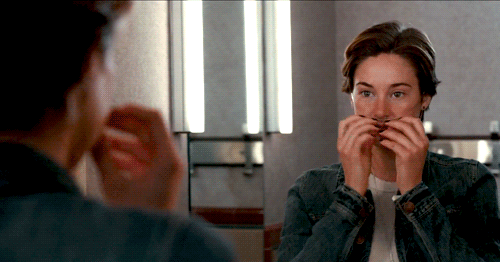
Hazel is the voice of this film, much as she is in the novel (in that case a little more literally). To start, Hazel is exceptionally honest. She is not stepping on egg shells but she’s also not being a jackass. Woodley is able to play Hazel’s jaded personality in an empathetic and relatable way. Throughout the film Woodley is nothing short of excellent with the ability to be funny, heartbreaking, vulnerable, angry, loving, and whatever else the story/character needs her to be. It is a phenomenal performance from a great actress and I think one of her best. This film needed a strong Hazel and I don’t think they could’ve cast a better one.
3) Remember how I said this film is strikingly honest?
Hazel: “The only thing worse than biting it from cancer is having a kid bite it from cancer.”
4) Angel Elgort as Augustus Waters.

Elgort is able to take a character who could’ve easily been kind of a creepy guy (a guy who works really hard to get with a girl who says no) and makes him wonderfully charming. Augustus could also easily have been a one dimensional pretentious boy toy. But author Green was able to make him more than that in the novel and Elgort is able to do the same in his performance. He infuses Augustus with a crazy amount honesty and heart, while also being able to play his fear and flaws (namely that of oblivion) in a way which makes him human.
5) A key aspect to this film is not only making sure Hazel and Augustus are strong on their own, but also that they have strong chemistry with each other. The key thing is that you are able to see why they’re friends first. There’s this immediate trust, shared sense of interest, shared sense of humor, and an immediate investment they have in each other. Also Woodley and Elgort are just GOOD together, because of whatever the x factor is that results in sexual chemistry.

6) Augustus’ whole thing with the cigarettes is REALLY extra. I kinda dig it.
Augustus [about why he uses cigarettes but doesn’t lit them]: “It's a metaphor, see: You put the killing thing right between your teeth, but you don't give it the power to do its killing. A metaphor.”
7) I’m probably going to talk a few times about how wonderfully honest this film is. There is no tiptoeing around cancer, it’s not glorified or romanticized or traumatized (it’s already pretty freaking traumatic). It just is what it is and these kids know what it is.
Hazel [about Augustus getting his driver’s license even though he sucks]: “Cancer perk.”
Augustus: “Total cancer perk.”
8) This is SUCH an important distinction.
Augustus [after he asks Hazel her story and he gets her cancer story]: “No, not your cancer story. Your real story.”
Knowing from first hand experience how easy it is to let cancer define your life, I think it’s important to make sure cancer does NOT define you. That when someone asks you about your story, your mind doesn’t immediately go to cancer. I love that the filmmakers and author John Green included this moment.
9) Laura Dern is remarkably strong as Hazel’s Mom. She is able to be positive, honest, but still plays the conflict of being a parent to a kid with cancer in every scene. It’s a great performance from the veteran actress and I think her relationship with Woodley comes through wonderfully. There’s an honest mother and daughter relationship there. They clearly love each other and are able to joke around with each other, even if they’re not being fully honest (which is how most parent/child relationships are). But when they are honest with each other, it’s a wonderful honesty.

10) Nat Wolff as Isaac.

Wolff (who rose to fame early on with “The Naked Brothers Band”) does a fine job in the supporting role. He fits nicely with Elgort and Woodley, feeling like an honest friend as opposed to a third wheel. His sadness and heartache comes through well, he’s able to be surprisingly funny at times, and it’s just a nice addition to the film.
11) Okay, so when I saw this in theaters I just KNEW who had read the book. And you wanted to know how I knew? Because they started crying when Augustus and Isaac were playing video games. That’s it. NOTHING SAD HAD HAPPENED YET! But still from the back of the theater all I could hear was:
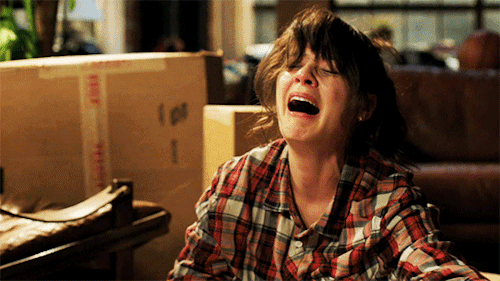
12) I geek out whenever they show the “Buffy” scene in this movie. Because it’s a Fox film, so they use things Fox owns like “Buffy” and Aliens instead of like V for Vendetta from the book (although a poster for the film does appear in Augustus’ bedroom). And there’s a parallel: the scene they’re watching in “Buffy” is one of great intimacy for eventual earth shattering heartache.

(GIF source unknown [if this is your GIF please let me know].)
13) This is sweet.
Augustus [after saying okay with Hazel a few times]: “Perhaps, ‘okay,’ will be our, ‘always.’”
Hazel: “Okay.”

(GIF originally posted by @oliversqueen)
14) This film plays remarkably well with visuals. There’s a lot of texting and email correspondence between characters which end up being important to the plot. This could’ve been boring but they use a nice doodle visual AND phantom images to keep our interest. It’s a nice touch.

(GIF source unknown [if this is your GIF please let me know].)
15) Oh Gus, look at you being all poetic. Subtle.
Augustus [at a piece of public art of a giant skeleton]: “They’re using a skeleton as a playground. Think about it.”

16)
Hazel [after a great day with Augustus]: “And then this happened.”
[Hazel wakes up in the middle of the night because she can’t breathe.]
Can I just say, from personal experience, cancer sucks. It fucking sucks. It seems like someone is doing well, that they’ve reclaimed some semblance of normalcy. Then cancer shows up to beat you down again. Fuck cancer. Cancer can go fucking die in a pit.
17) Well, this is heartbreaking.
Hazel’s Mom [in a flashback to when Hazel was 13 and dying]: “I’m not going to be a mom anymore.”
This is very key to Hazel’s primary conflict in the film, but more on that later.
18) A film is a story told in cuts.
Augustus: “Well, I demand to see this swing set of tears.”
[Immediately cut to Augustus and Hazel sitting on said swing set.]
19) This is very true of the attitude I have known some cancer patients to have.
Hazel [trying to push Gus away]: “Gus, I’m a grenade. One day I’m going to explode and I’m going to obliterate everything in my wake. And, I don’t know, I feel like it’s my responsibility to minimize the casualties.”
20) Nice to know that Augustus is being honest with himself though.
Hazel [after her mom says she and Augustus are cute together]: “We’re just friends.”
Augustus: “Well, she is. I’m not.”
21) The date night between Augustus and Hazel on the town in Amsterdam is very cute and the connection they’re able to portray with almost no dialogue speaks greatly to the chemistry between Woodley and Elgort.
22) Augustus’ declaration of love is done VERY well.
Augustus [almost out of the blue]: “I am in love with you. You heard me. I am in love with me.”
This scene is very organic and honest. It feels like the most natural next step for not only the scene but their relationship as well. It doesn’t feel forced or awkward it makes sense. And I think both Elgort and Woodley play the scene wonderfully.
23) I kinda realized half way through this film is effortlessly feminist. We make a big deal sometimes out of honest female representation in the media but honestly it hardly comes to mind with this film because all the characters - male and female - are easily honest. You don’t even think about it, they just are three dimensional characters throughout. It’s surprisingly refreshing.
24) Willem Dafoe as Peter Van Houten.

I’m not one to say to never meet your heroes, but if you do make sure your expectations are considerably low. This way if they’re a raging asshole like this guy you won’t be too disappointed. Because that’s what Van Houten is. An asshole. A raging, pretentious, alcoholic douche bag who thinks he’s SO above everything. Literally no part of the meeting Hazel and Augustus have with him goes well, leading to a very expected and very cathartic blow up. Dafoe plays the asshole well, making him a character we love to hate and a nice aspect of the film.
25)
Van Houten: “How familiar are you with Swedish hip hop?”
If you want to avoid vulgar lyrics in your music, do NOT google the translation to the Bomfalleralla. It’s worse than you might think.
26) This is SO key to Hazel’s conflict.
Hazel [asking Van Houten about his characters’ lives after the book]: “But that doesn’t mean her family and her friends don’t have a future [after the narrator dies], right?”
As Hazel will observe later, this is her biggest fear. It seems she has made her death with peace and dying but she is so terrified of how she is going to hurt the people she loves. That is the most key internal conflict she has in the film and one which will be consistent until the end.
27) The Anne Frank House.

More than anything else, this serves as incredible show of strength for Hazel. She is fighting to live, and choosing life over death by deciding to be with Augustus even if it’s only for a limited amount of time. The setting of the Anne Frank House drives home the idea of life’s unfortunate impermanence. I’m sure the use of Anne’s narration underscoring the scene acts as some grand literary device but it is difficult for me to analyze it because I am so invested in Hazel’s struggle in the scene.
28) The love scene between Hazel and Augustus is incredible. And not because it’s sexy or because it’s hot or anything. It is because it is honest. There is this incredible comfort they have around each other. They’re comfortable with their scars, with their tubes, with their limitations. They don’t worry that it will turn the other person off. It is a vulnerability born out of complete and utter trust, a trust which is not abused but respected by both parties. It is incredibly tender and just very loving.
29) Did I mention cancer sucks?
Augustus: “I felt an ache in my hip.”
Okay, Hazel just fucking KNOWS what he is about to tell her. As soon as he says, “I felt an ache in my hip,” you can see it on her face. She knows where this is going because she is uncomfortably familiar with how cancer works. And it’s heartbreaking.
30) According to IMDb:
Soon after the film's release, the street bench on which Gus and Hazel had their embrace was stolen. A few months later, it was replaced by the city of Amsterdam.
People suck.
31) It’s nice to see that this film still has a sense of humor and life to it in the face of death.
Augustus [after Hazel says they should wait until after dark to egg someone’s house]: “It’s all dark to Isaac.”
Isaac [after a second]: “Dude, I’m not deaf. I’m just blind.”
32) One of Ansel Elgort’s standout scenes is his breakdown at the gas station. Hazel even observes that she wishes she could say he’d held his courage and sense of humor to the end, but that’s not how life works. This is very honest. This kid is freaking dying of cancer! Of course he’s going to breakdown! And Elgort plays that sadness totally honestly and in an utterly gut wrenching way. It’s his standout scene in the entire film.
33) I love that Hazel calls him out on this.
Augustus: “I mean I was supposed to be special.”
It doesn’t matter if everyone likes you as long as one person loves you. If you’re important to someone it doesn’t matter that you’re not important to everyone. Just because we’re all not famous or infamous or historic does not mean we are not special.
34) Hazel’s biggest fear is that her parents won’t have a life after she dies, because her death is a fact to her. But when her parents tell her that they’re being productive, that her mother is studying social work and that they will have a life after her death, she is just so freaking happy. This incredible weight has been lifted off her shoulders, she is not the grenade she thought she was. It makes me tear up, honestly.
35) Hazel’s eulogy.
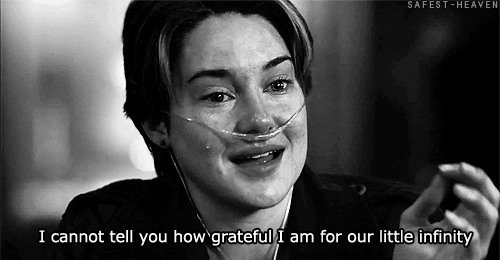
This is the climax of the film. The moment the rest of the movie has been building up towards, the moment their relationship has been leading to. It defines that relationship. Woodley shines in her monologue and Elgort shines in his quiet reaction. It is heartwarming and heartbreaking all at once and just totally incredible. And this line emphasis the impact they have had on each other’s lives:
Hazel: “Some infinities are bigger than other infinities.”
36) There was this analytical post when the movie first came out that pointed out the shirt Hazel is wearing when she learns Augustus died is HIS tee shirt. I just can’t find any post about it because anytime you google, “Fault in Our Stars Tee Shirt,” you get a link to the song by Birdy that’s in the film. If you guys have this bookmarked anywhere I’d love to hear about it, but the fact that Hazel is wearing Augustus’ shirt when she learns he died is heartbreaking to me.
37) Hazel realized something quite important here.
Hazel [after making up a eulogy on the spot different than the one she read for Augustus]: “I didn’t believe a word. But that’s okay…Funerals, I decided, are not for the dead. They’re for the living.”
38) “Not About Angels” is still one of the saddest songs I’ve ever heard. It breaks my heart every time. I feel like breaking down and crying whenever I hear it. Here, share in my pain:
youtube
39) Augustus’ final letter to Hazel is a perfect resolution the film. It speaks greatly to not only Augustus’ character but also the relationship he and Hazel had. It is a wonderful emotional resolution which I think just work beautifully.
Augustus [at the end of his letter]: “Okay Hazel Grace?”

The Fault in Our Stars is a moving and honest film supported by a great cast and a wonderful method of adaptation. The spirit of John Green’s source material is alive and well in the film, with performers like Shailene Woodly and Ansel Elgort breathing incredible life into these characters. The film can be funny and heartbreaking all at the same time, but it never falters in its honest approach to these characters. Absolutely wonderful, I suggest everyone see it.
#The Fault in Our Stars#Shailene Woodley#Ansel Elgort#John Green#Hazel Grace Lancaster#Laura Dern#Nat Wolff#Willem Dafoe#Birdy#Epic Movie (Re)Watch#Movie#Film#GIF
10 notes
·
View notes